Life is an adventure, and there’s no better time than now to explore the world’s most incredible destinations. If you’re looking for a ’40 before 40′ bucket list to complete before you hit 40, I’ve got you covered. The list includes the most iconic landmarks: the world’s wonders, forests, cities, and deserts. Turning 40 marks a significant milestone in life. It is a time of reflection, growth, and adventure.
- 1. Giza, Egypt
- 2. Rome, Italy
- 3. The Taj Mahal, India
- 4. Machu Picchu, Peru
- 5. Great Wall of China
- 6. Rio de Janeiro, Brazil
- 7. Chichén Itzá, Mexico
- 8. Cape Town, South Africa
- 9. Amazon Rainforest, Brazil
- 10. Iguazu Falls, Argentina/Brazil
- 11. Jeju Island, South Korea.
- 12. Komodo Island, Indonesia
- 13. Ha Long Bay, Vietnam
- 14. New York, USA
- 15. Los Angeles, USA
- 16. Hawaii, USA
- 17. Alaska, USA
- 18. Paris, France
- 19. Venice, Italy
- 20. London, UK
- 21. Cinque Terre, Italy
- 22. Cappadocia, Turkey
- 23. Great Barrier Reef, Australia
- 24. Pamukkale, Turkey
- 25. Meteora, Greece
- 26. Barcelona, Spain
- 27. Budapest, Hungary
- 28. Sardinia, Italy
- 29. Istanbul, Turkey
- 30. Scottish Highlands, Scotland
- 31. Serengeti National Park, Tanzania
- 32. Florence, Italy
- 33. Santorini, Greece
- 34. Zanzibar, Tanzania
- 35. Bali, Indonesia
- 36. Kyoto, Japan
- 37. Dubai, UAE
- 38. Yosemite National Park, USA
- 39. Grand Canyon, USA
- 40. Prague, Czech Republic
1. Giza, Egypt
Obviously, top of the top, the only surviving ancient wonder. If you didn’t have a chance to kiss the Sphinx, dodge pushy sellers, and still get your share of Egyptian history, here’s the time. Moreover, the long-awaited Grand Museum opened its doors not far from the Giza Plateau. Check this guide for more details.
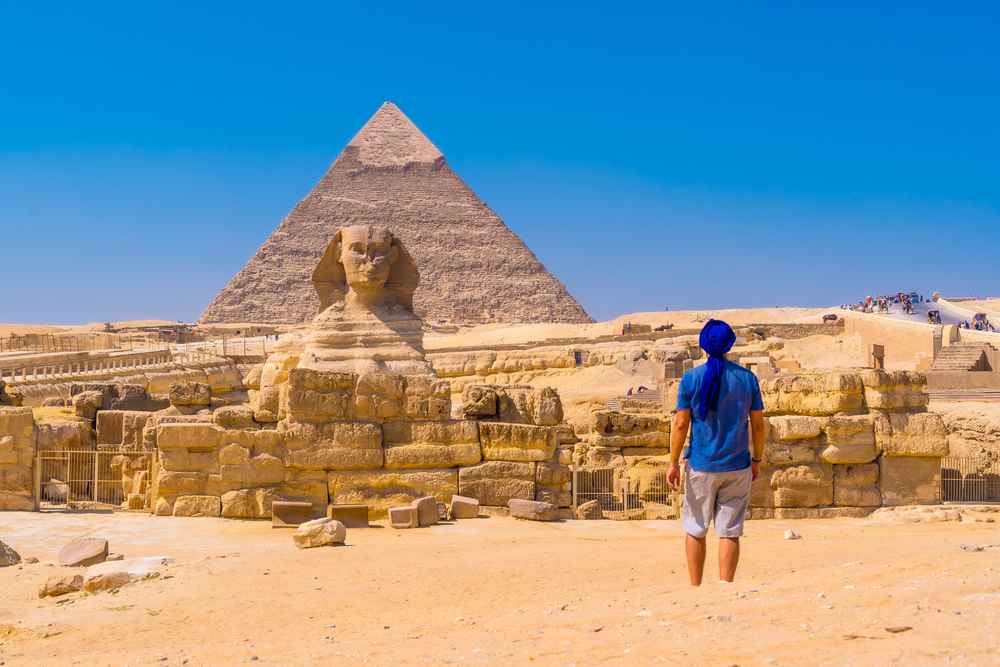
2. Rome, Italy
You’ve seen Rome a hundred times without ever booking a flight — in Eat Pray Love, The Lizzie McGuire Movie, every pasta commercial with a Vespa, and that Succession finale where the billionaires schemed under frescoes.
Start at the Colosseum — not because it’s on every list, but because it’s the origin story of spectacle. This is where drama was invented, long before HBO. Nearby, the Pantheon still holds the record for “how is this even still standing,” and it’s free to enter (your bank account will appreciate that). Toss a coin into the Trevi Fountain not to make a wish, but to mark that you’re finally here.
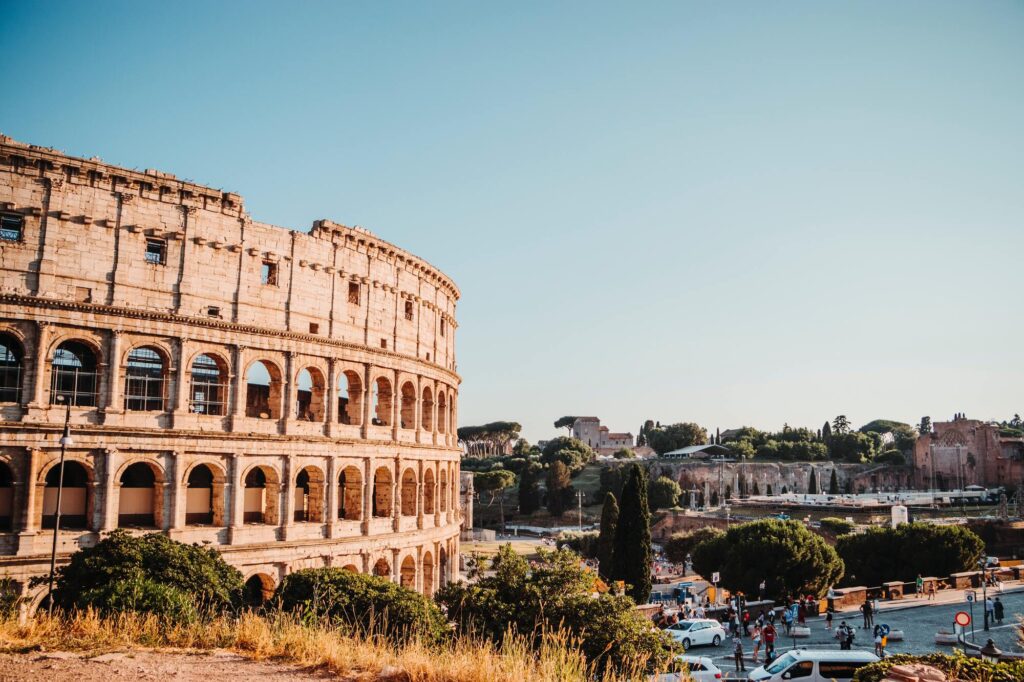
And then — the Vatican. Even if you’re not religious, this city-within-a-city is shifting again. There’s a new Pope, a new energy, and it’s a rare moment to witness history as it unfolds inside centuries-old ritual. You don’t need to believe in anything to be moved by Michelangelo’s ceiling or the silence inside St. Peter’s.
3. The Taj Mahal, India
You’ve seen it on postcards, screensavers, maybe someone’s engagement shoot — the Taj Mahal always looks surreal. But standing in front of it is something else entirely. It’s not just a monument, it’s a contradiction: immense but delicate, solemn but romantic, iconic yet personal.
Built by Mughal emperor Shah Jahan for his late wife, the Taj is a grief offering turned architectural masterpiece. It’s not about checking off a world wonder — it’s about being in a place where loss became beauty. You don’t have to be in love to feel it. You just have to stand there as the white marble shifts color with the sky and realize how rarely we build anything out of feeling anymore.
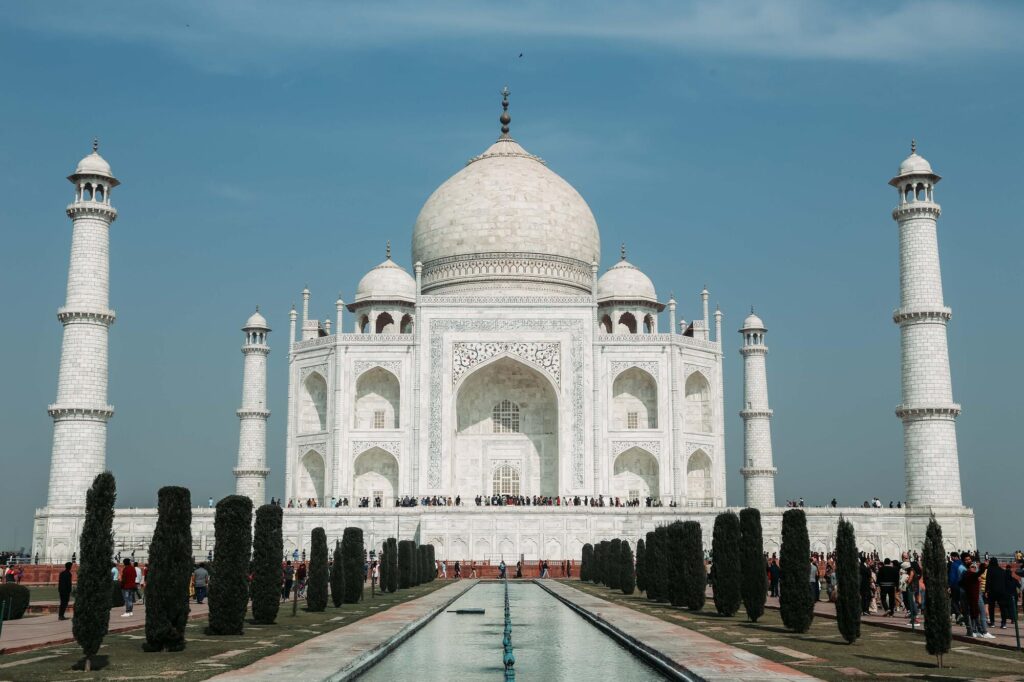
If you’re coming from Delhi, it’s a fast train or a private car ride away. Go early. The crowds are unavoidable, but the sunrise softens everything — even your inner monologue.
And before you leave, take a quiet walk down the Yamuna River’s banks. The view of the Taj from there is unfiltered, almost forgotten by tourism. It feels like the real memory you’ll keep.
4. Machu Picchu, Peru
You’re deep in the Andes before you even realize it. The train from Cusco — the same route Hiram Bingham took over a century ago — winds past villages and farmland until the cliffs start to close in. Somewhere along that stretch, it stops feeling like a trip and starts feeling like you’ve slipped into a different timeline.
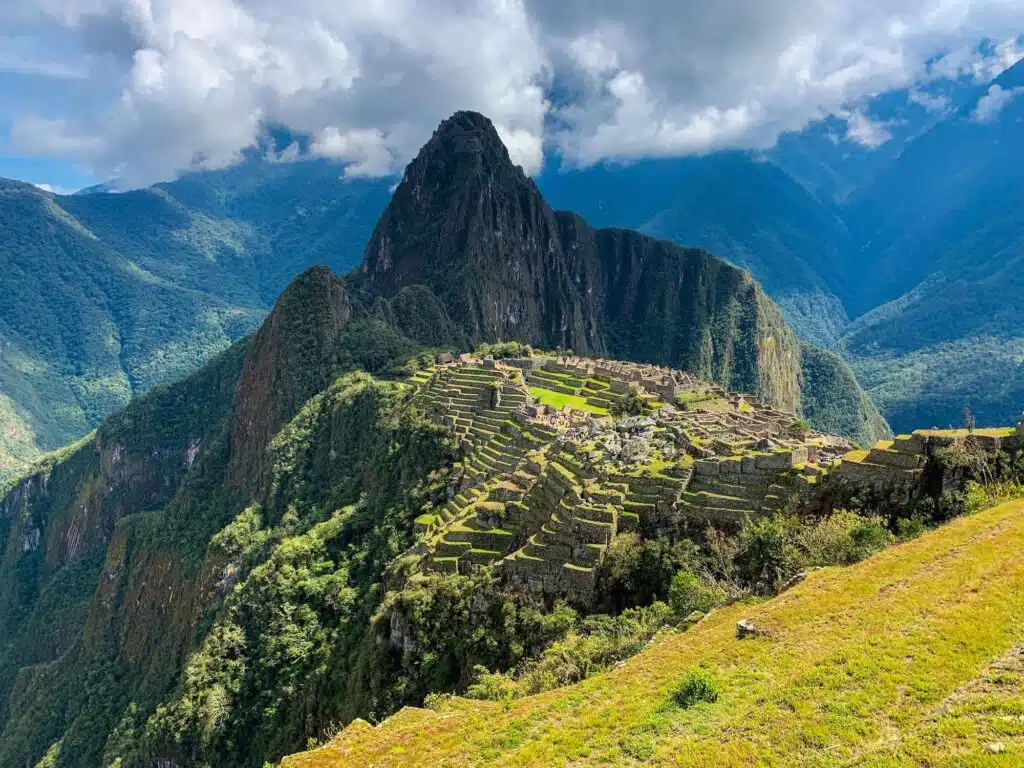
You can hike it, too. The Inca Trail still runs like it did centuries ago — switchbacks, ruins, cloud forest, and all. Or take the Salkantay route if you want altitude and fewer crowds. Either way, arriving on foot changes your pace before you ever reach the citadel.
Bingham called it a “lost city” when he reached it in 1911, though locals already knew it was there. Ollantaytambo and the rest of the Sacred Valley are part of the same story. They give the place context, not in the guidebook sense, but the kind that lingers.
5. Great Wall of China
The Wall sections you visit near Beijing (Mutianyu, Jinshanling, Simatai) are Ming dynasty stonework, layered over centuries of older earth and fortification lines from the Qin era. It was built both for defense and to send a message: this is where a dynasty ends, and uncertainty begins.
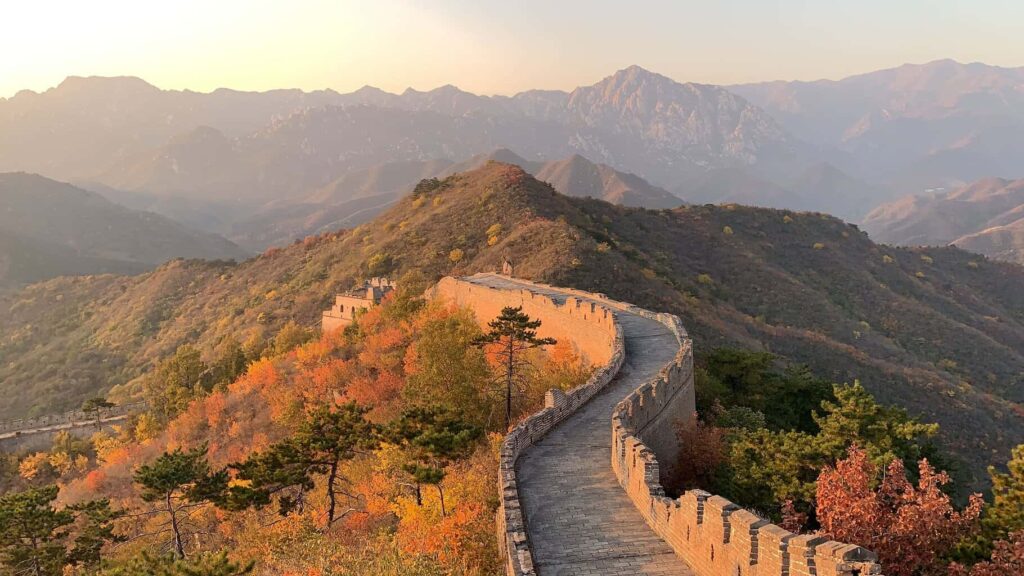
Mutianyu is the easiest base, with better condition due to restoration, and less packed than Badaling. Jinshanling is more remote, steeper, and less rebuilt. Both stretch across ridgelines that feel endless. You can see why Kafka once used the Wall as a metaphor, not for strength, but for the feeling of building without seeing the whole plan.
A few people have walked its full length, most visitors see only a stretch. That’s enough. Every section tells a slightly different version of the same story: effort, erosion, and the idea of permanence.
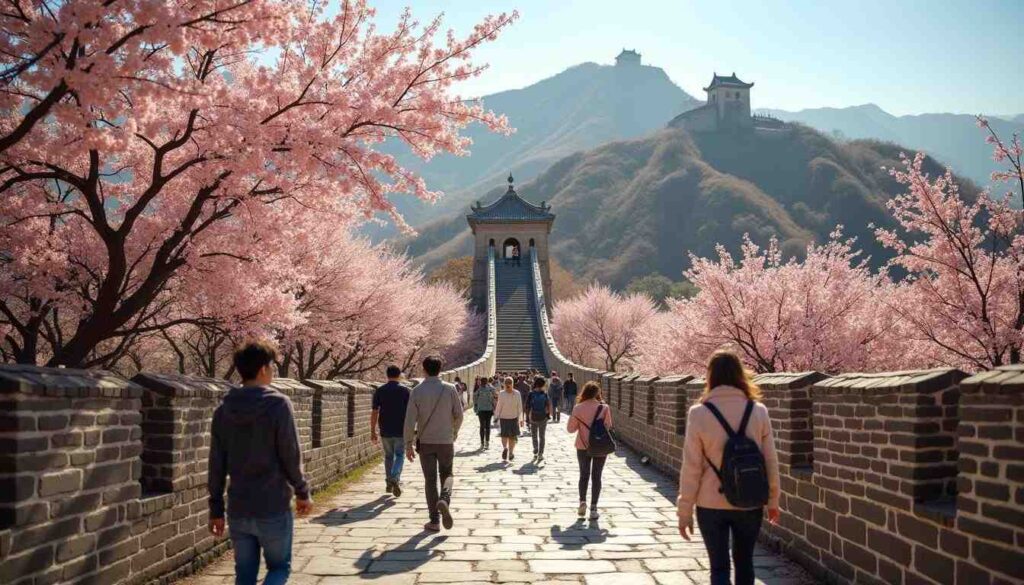
Zhang Yimou turned it into a fantasy battlefield in The Great Wall (2016), with Matt Damon fighting dragons. The premise was wild, but the setting didn’t need much embellishment; it already feels otherworldly.
In 1987, the wall made its way into the UNESCO World Heritage list, and it hosts one of the most famous half marathons.
6. Rio de Janeiro, Brazil
Rio feels like it was designed by someone with a sense of humor — granite peaks dropped straight into the Atlantic, samba drifting through traffic, and neighborhoods that run from beachfront to jungle without warning. You’re in a city, but the edges blur fast.
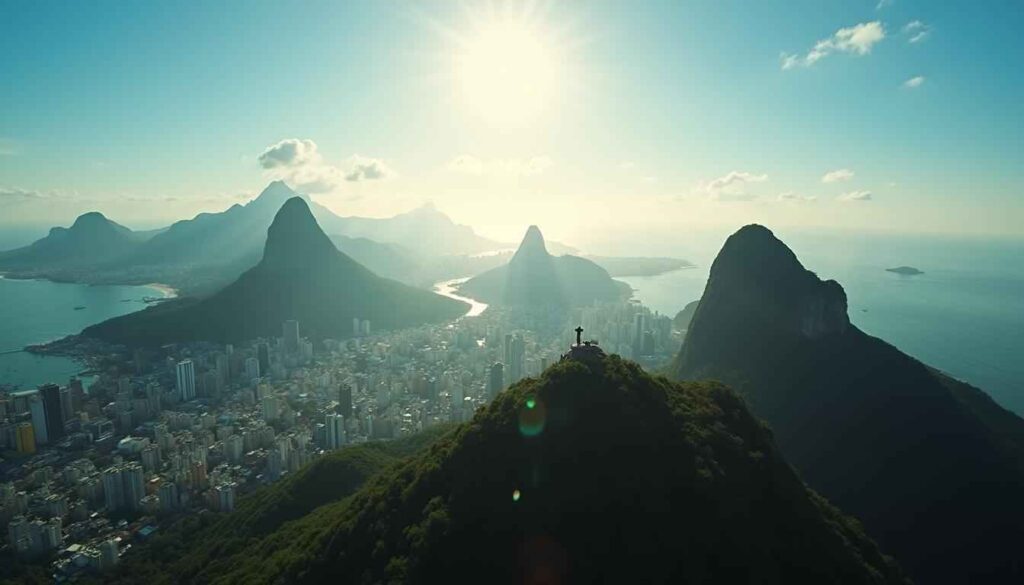
It’s impossible to unsee once you’ve seen it on film. City of God gave it grit, Fast Five gave it speed, and The Girl from Ipanema is still playing in someone’s head when you land. The contrast isn’t new — Rio’s always lived between postcard and punchline.
Christ the Redeemer is visible from almost everywhere — less of a monument, more of a reminder. And Sugarloaf, with that cable car made famous by Moonraker, is still worth riding for the view alone. But the real rhythm comes from neighborhoods like Santa Teresa with its tiled staircases and late-night bars, or from a morning on Copacabana that turns into a whole day without planning to.
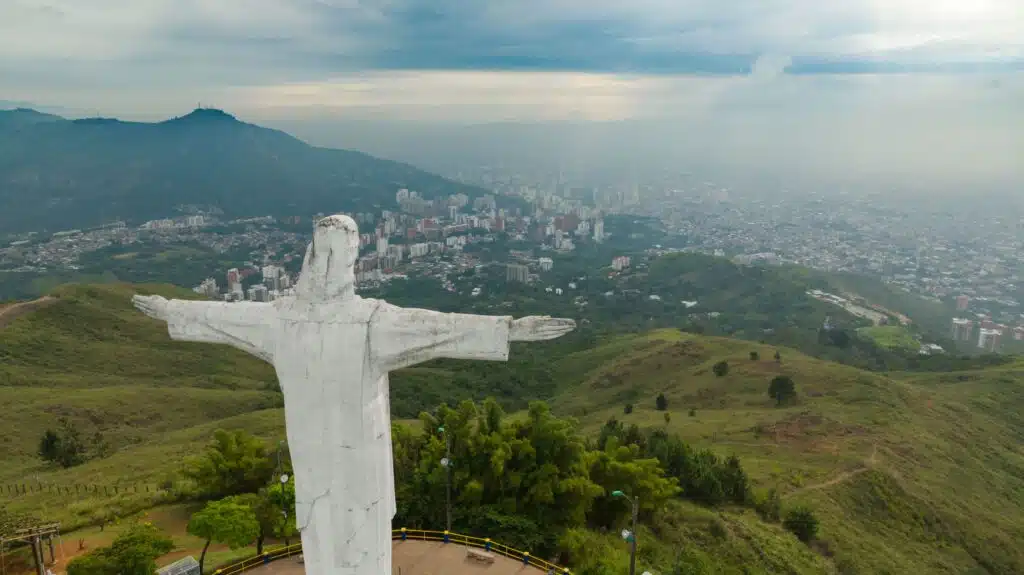
For a different kind of perspective, take the tram to the top of Morro da Urca or head into Tijuca Forest — the world’s largest urban rainforest, hiding waterfalls and monkeys inside city limits.
7. Chichén Itzá, Mexico
The pyramid rises out of flat ground like it’s been waiting. El Castillo isn’t massive by modern standards, but every angle is sharp, every step intentional. On the equinox, shadows line up perfectly along the staircase, creating the illusion of a serpent sliding down the stone. It’s not a myth. It happens twice a year, right on time.
The Great Ball Court nearby carries sound in a way that feels impossible — clap once, and it echoes seven times. It’s not restored with gloss or signage. Most of what you see was built over a thousand years ago by people who didn’t leave behind an instruction manual.
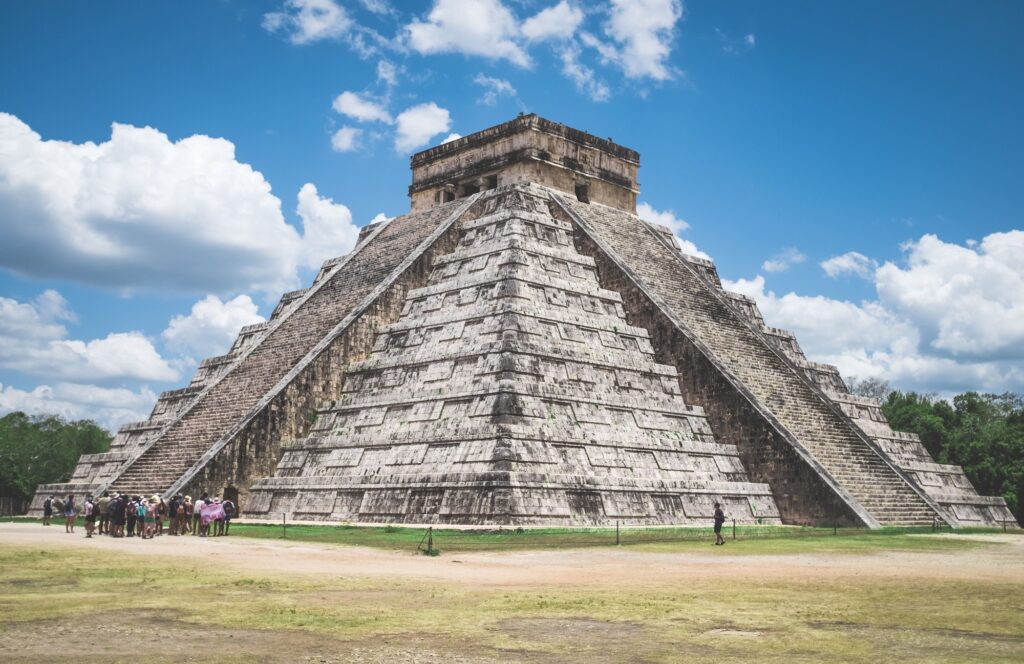
You’ve probably seen it before without realizing — on the cover of Assassin’s Creed IV: Black Flag, in the background of a Beyoncé music video, in that episode of The Simpsons where the family tours Mexico and everything goes sideways. Even Tomb Raider: Underworld dropped Lara Croft at the foot of its stairs. But when you’re actually there, none of that matters. The scale feels quieter. More exact. Like it was built for the sky, not the screen.
If you’re coming from Mérida or Valladolid, go early. The heat kicks in fast, and so do the tour groups. What feels ancient at 8 a.m. can feel like a theme park by noon.
8. Cape Town, South Africa
Table Mountain cuts the skyline like a stage prop, and the Atlantic doesn’t bother warming up. You land in the middle of extremes — cliffs and townships, vineyards and protests, sea spray and apartheid museums. It’s not seamless, and it’s not trying to be.
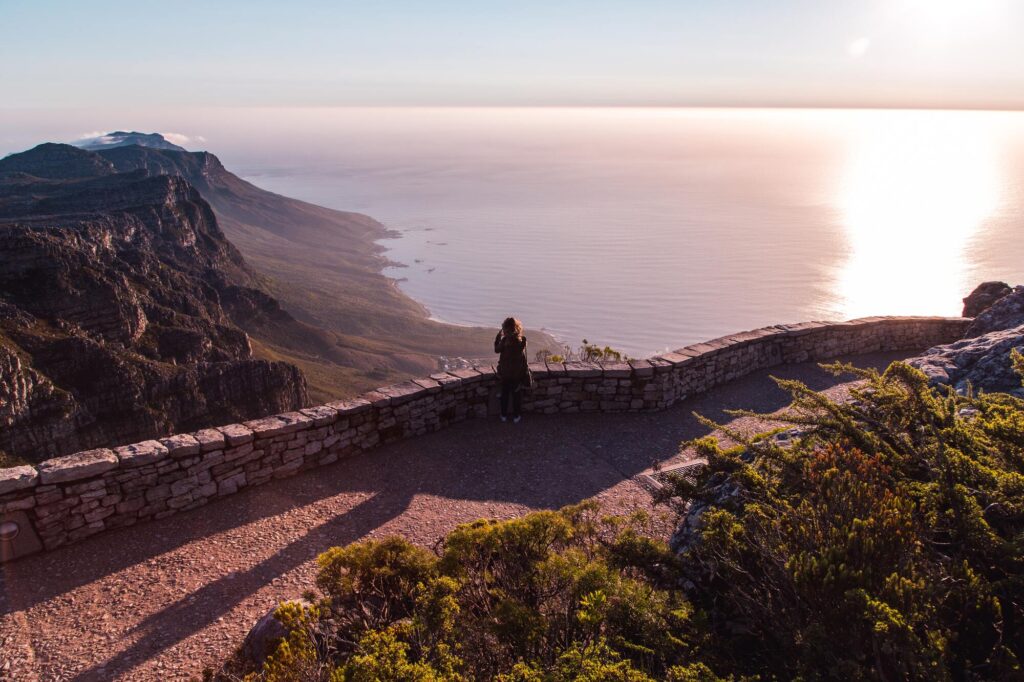
Robben Island sits offshore, where Mandela spent 18 years behind bars. You can visit by ferry; the view of the city from the prison yard is hard to explain, but it stays with you. In town, the District Six Museum pulls you into the middle of a neighborhood that was erased, house by house, under forced removals.
Parts of Blood Diamond were filmed nearby. Mad Max: Fury Road used these landscapes to suggest the end of the world. But Cape Town doesn’t feel post-apocalyptic.
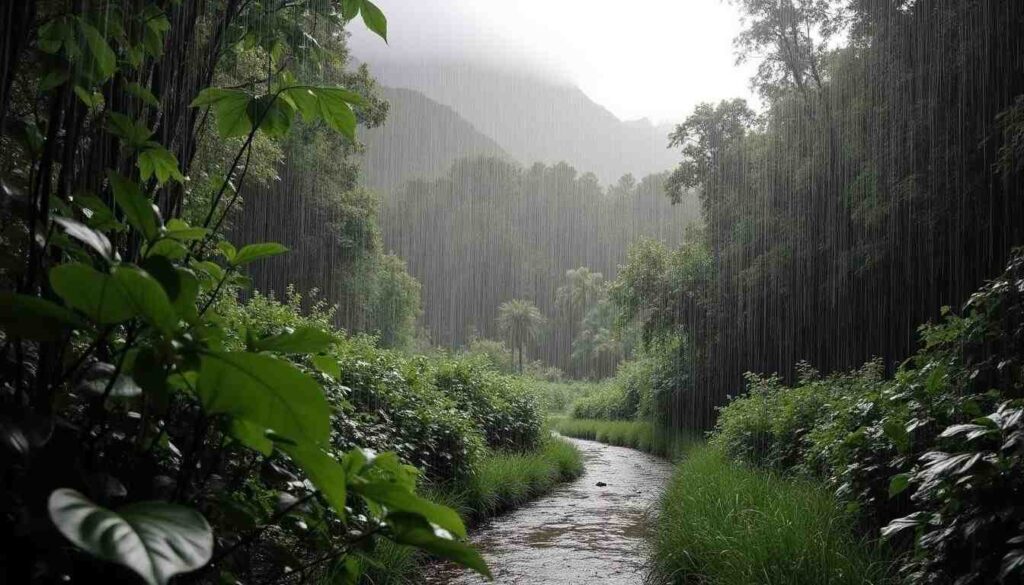
Kirstenbosch Botanical Garden was one of the settings that gave Blended (2014) its scenery. While most of the movie was shot at Sun City, the garden’s green arches and forested footpaths filled in for “Africa” when Hollywood needed lush without needing to explain it. In one scene, the characters walk through what’s clearly Kirstenbosch’s canopy trail, sold as a luxury safari resort experience.
9. Amazon Rainforest, Brazil
The flight into Manaus feels like you’re landing on a green ocean, endless canopy in every direction. The city itself is a strange gateway: part river port, part opera house legacy, part basecamp. From there, the rainforest begins without ceremony.
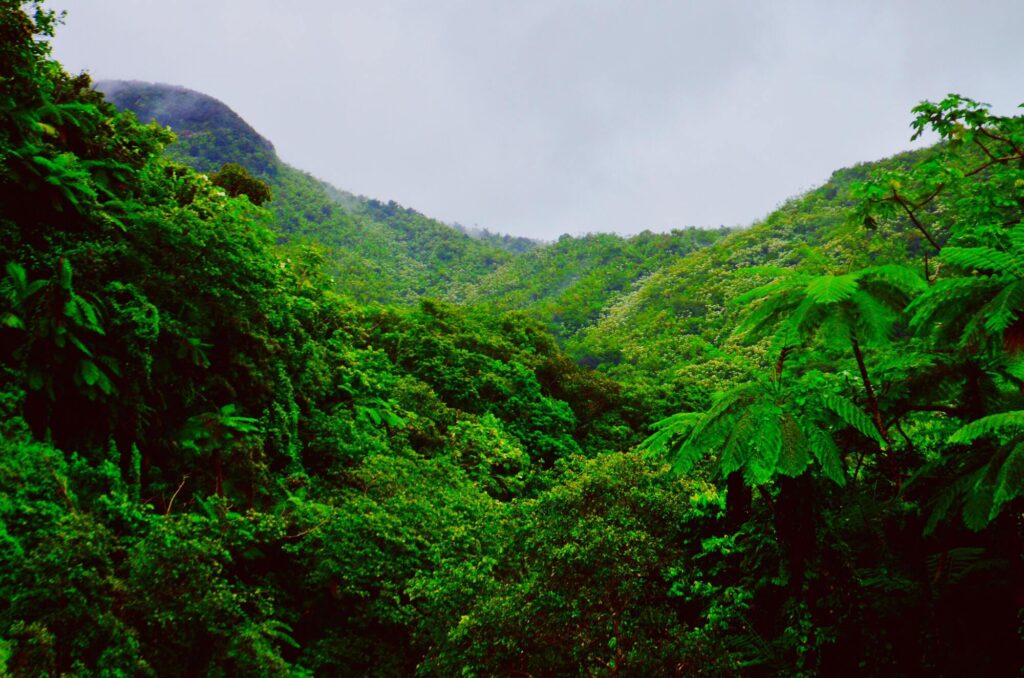
You’ve seen it in The Emerald Forest, The Motorcycle Diaries, and Werner Herzog’s Fitzcarraldo — especially that last one, where an opera house is hauled through the jungle in a true story that feels like fiction. The actual building is still in Manaus, a leftover from the rubber boom, standing proud and out of place in the middle of the rainforest.
Lodges range from hammock-basic to solar-powered boutique, depending on how far you’re willing to go. Boat trips on the Rio Negro or along the flooded forest near Anavilhanas open up parts of the Amazon where the line between water and land disappears completely.
10. Iguazu Falls, Argentina/Brazil
Being the largest waterfall system in the world, the falls stretch across both Argentina and Brazil. Each side shows a different angle — the Brazilian for sweeping panoramas, the Argentine for walkways that pull you almost inside the spray. Most of the paths feel suspended, like you’re walking through the air just above the river.
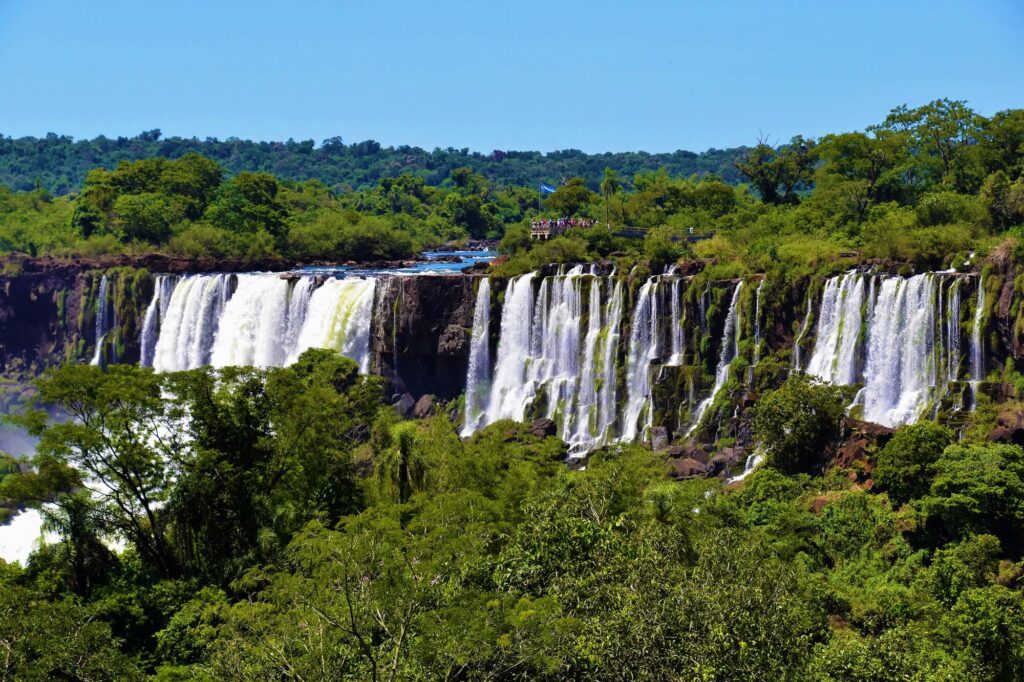
You might recognize it from The Mission (1986), where a Jesuit priest plays a theme on a cliff above the falls, or from Black Panther, which used Iguazu as the edge of Wakanda. Both moments lean on the same thing: scale. It looks unreal, but it’s not CGI.
The border cuts through the middle of the river, but the water ignores it. So do the birds, the humidity, and the mist that soaks your clothes within minutes of arrival.
11. Jeju Island, South Korea.
Off the southern coast of Korea, Jeju builds slowly. Black volcanic stone walls run between fields. Wind moves through tangerine trees. Hallasan rises in the center, ringed by forests and low clouds. The elevation changes so gradually that you only realize you’re climbing when you start to feel it.
Some know Jeju through K-dramas — Our Blues, Warm and Cozy, Crash Landing on You. It’s the place characters go when they need something to shift. Cafes on the edge of fields. Empty stretches of trail. Long silences between scenes.
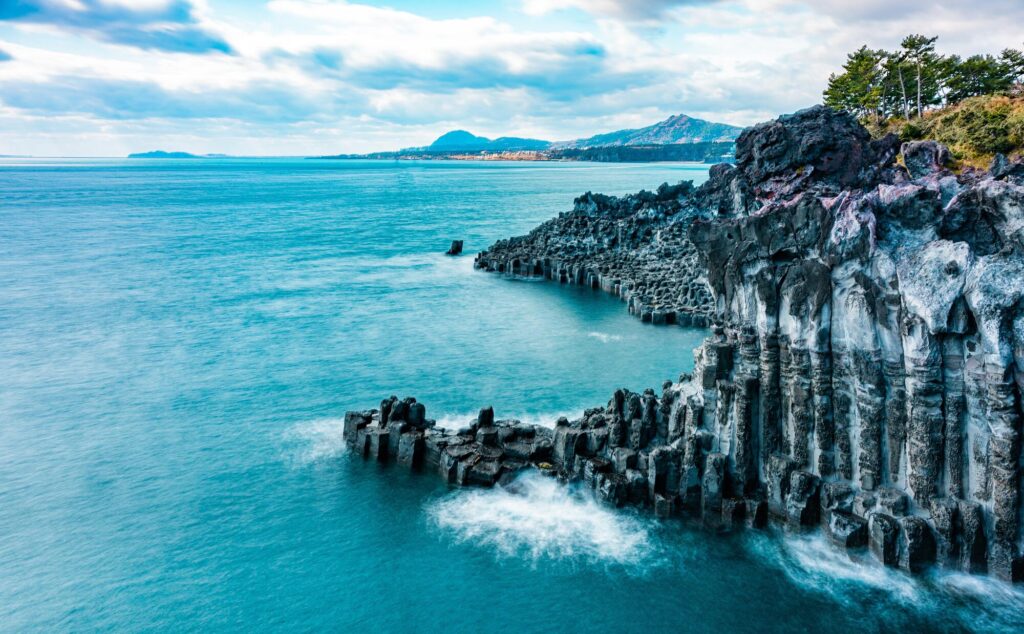
The haenyeo, free-diving women, who’ve worked the sea for generations, still dive off the coast for abalone and urchins. You’ll see them on shore, unbothered by the attention. Their catches end up on plastic plates in coastal shacks that don’t bother with signs.
Seongsan Ilchulbong gets the sunrise crowds. The Jeju Olle Trail runs around the island in pieces. Most people walk it in sections — a few hours here, a day there — watching the scenery fold between cliffs, farms, and small harbors.
12. Komodo Island, Indonesia
The boats leave from Labuan Bajo. Early morning, sometimes before light, moving out past small islands that don’t seem inhabited, toward one that still carries its name like a warning. The heat picks up fast. So does the stillness.
Komodo dragons live in plain sight. They don’t perform. You might spot one sprawled across a trail, another dragging its weight through underbrush, flicking its tongue with the kind of slowness that makes you step back before you think about why. Most visitors come for the dragons, but the scenery stays: ridgelines with narrow trails, pink-sand beaches, water so clear the drop-off looks painted.
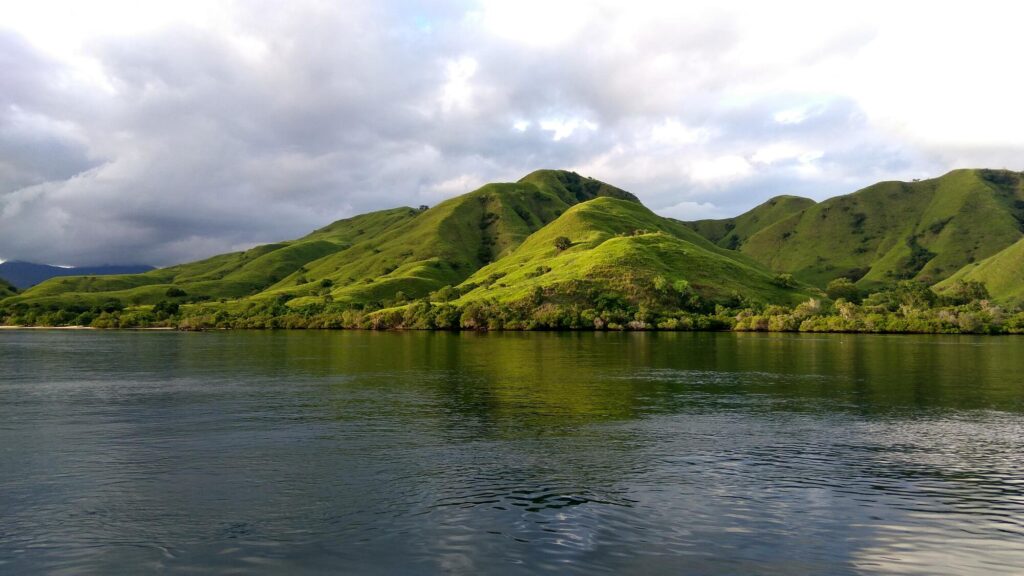
Some of Killing Season was filmed in the surrounding archipelago, though most shots blur place into backdrop. The real visual memory is the one that comes from hiking up to Padar Island’s ridge at low light, where the curved bays divide the land like folds in a map.
13. Ha Long Bay, Vietnam
The boat moves slowly as the green water, limestone pillars, and the kind of mist that doesn’t lift by noon. From a distance, the formations look placed, but up close, the cliffs rise with detail: streaked rock, sudden overhangs, and birds tracing the ridge lines like they know the route by heart.
Some cruises stay out overnight. As the light fades, the cliffs fall into shadow and the water turns dark enough to reflect stars. If you’re lucky, the plankton light up, tiny flashes just under the surface, stirred by the boat, like the bay is holding something back until the crowds go home.
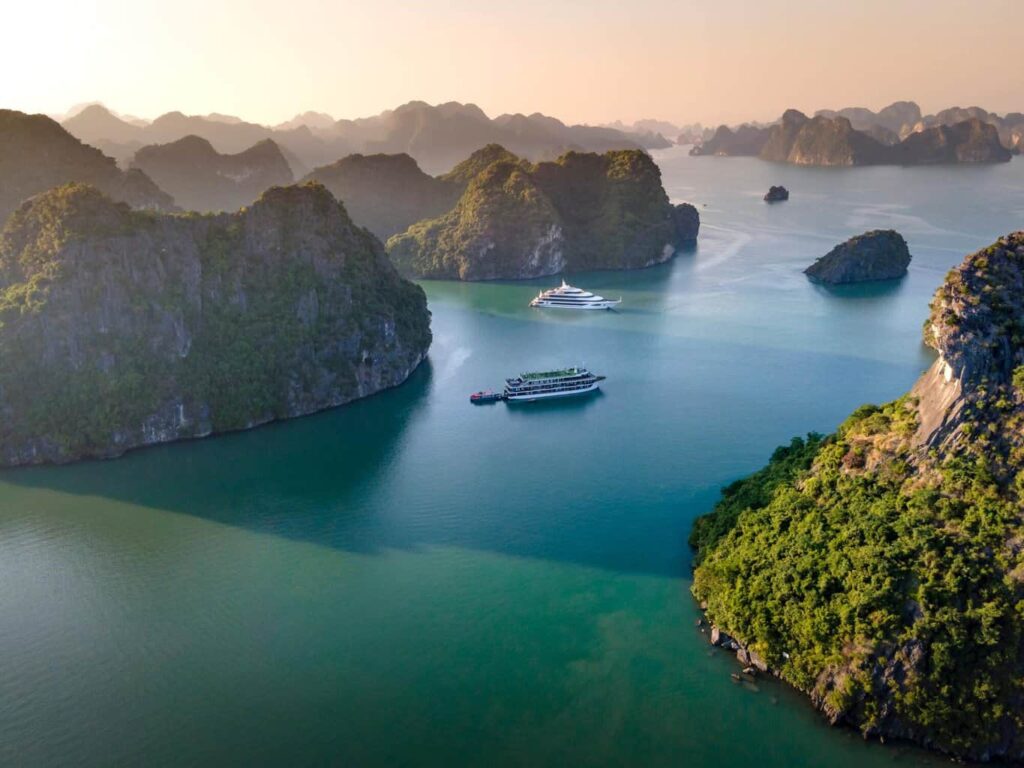
Indochine (1992) was filmed here with long silences and sweeping shots across the bay. Kong: Skull Island came later, pushing the terrain into something stranger, but the real setting already did the work.
The bay holds over 1,500 islands and inlets. Some can be circled in a kayak before the tide shifts. Others hold caves or floating homes, nets pulled tight with the day’s catch. Every curve of the coast feels like it leads somewhere else — or nowhere at all.
14. New York, USA
The first skyline most people ever see is this one — on a screen, in a book, behind a character they’ve followed. From the opening bars of Sex and the City to the pigeon-covered plaza in Home Alone 2, the city filters in long before your plane does.
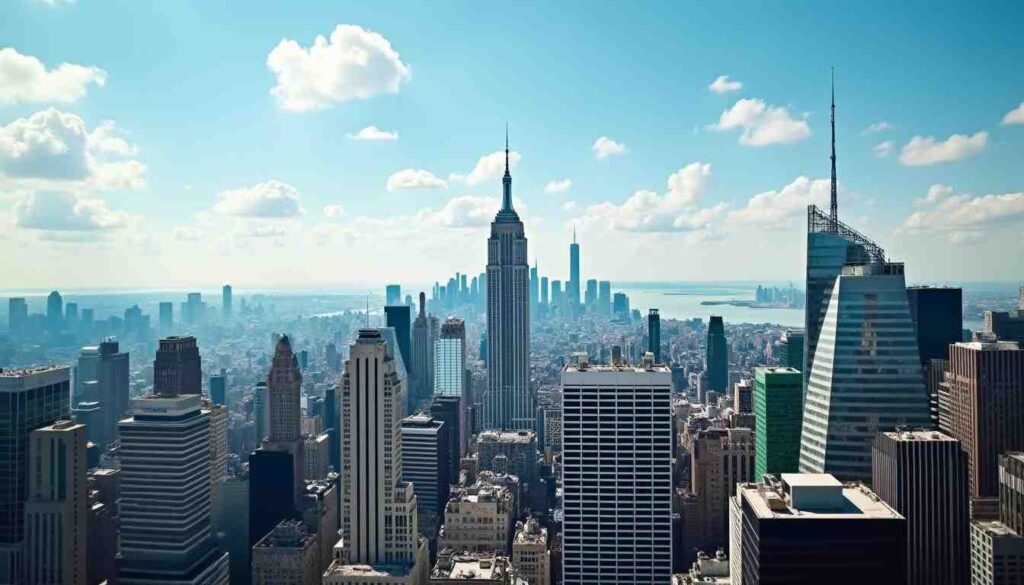
At The Plaza, Kevin McCallister checked into a suite with room service and a stolen credit card. Carrie Bradshaw wrote from a brownstone that wasn’t technically hers. Ghostbusters crossed streams at the top of 55 Central Park West. In When Harry Met Sally, Katz’s Deli still serves the same pastrami. In Do the Right Thing, Bed-Stuy still sweats in the August heat.
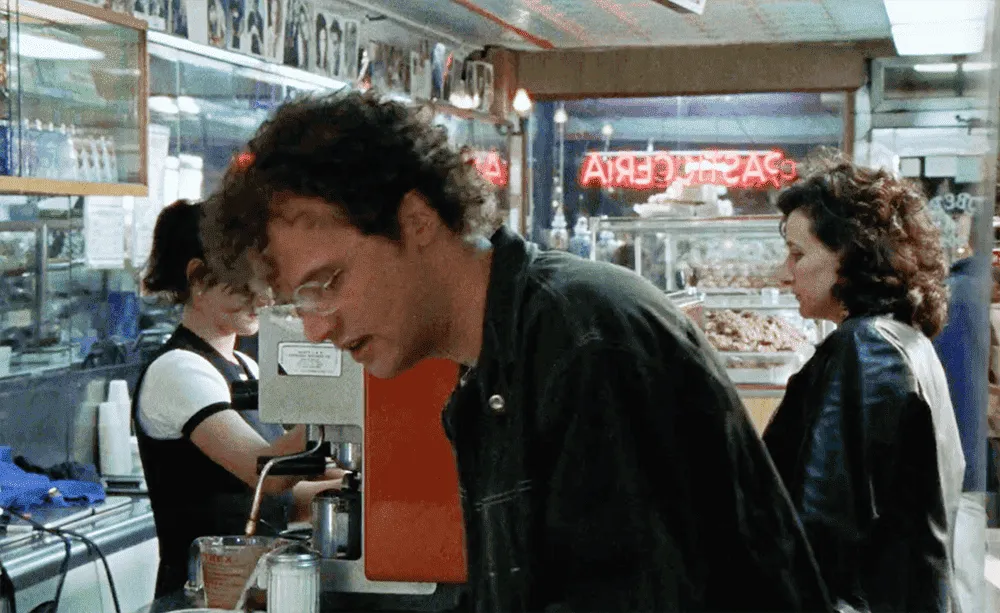
You could spend an entire day visiting nothing but movie locations and still miss most of them. The steps of the Met. The Chrysler Building. The bridge from Manhattan. Grand Central can feel like Mad Men or Gossip Girl. Times Square flips between Vanilla Sky emptiness and The Marvelous Mrs. Maisel glow. The Public Library is a wedding venue, a ghost trap, and the place where Charlotte first saw Big read a book.
Every block holds layers. Jazz in Harlem basements. Pizza from the window at Joe’s. That corner in Washington Square where the chess players never leave.
15. Los Angeles, USA
The opening shot from La La Land. The drive on Mulholland in Mulholland Drive. The diner booth from Reservoir Dogs. Even if you’ve never been to Los Angeles, you’ve probably been to Los Angeles.
There’s the Walk of Fame and the Chinese Theatre, both still there, still chaotic. Rodeo Drive looks like it did when Julia Roberts walked into that boutique in Pretty Woman, and the Beverly Hills Hotel still leans pink and palm-lined, a place that pretends not to notice the cameras anymore.
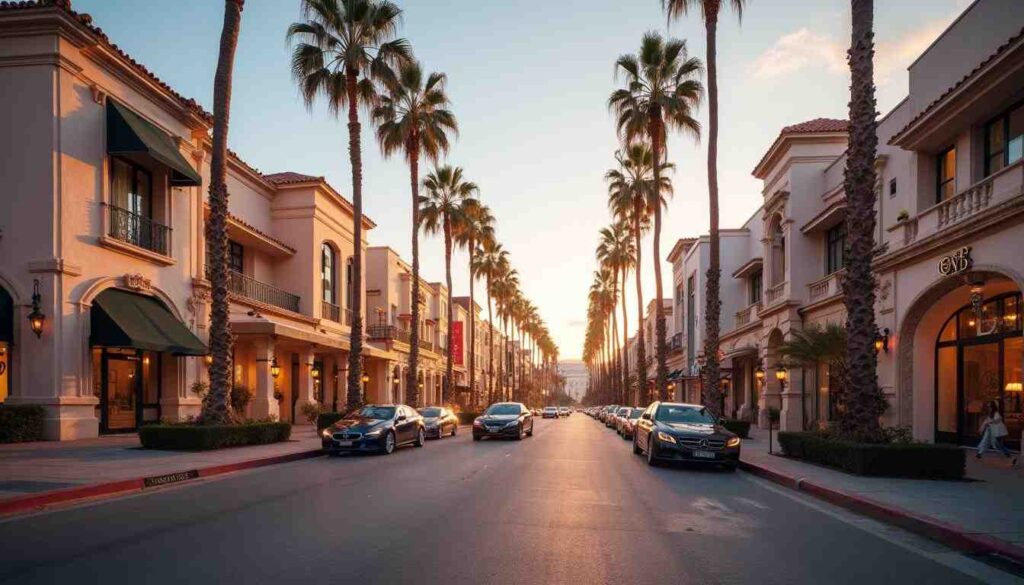
Downtown carries layers — Blade Runner rain, 500 Days of Summer rooftops, Inception folding its own streets back in. At the Bradbury Building, elevators still glide through the same ironwork that held The Artist, The Terminator, (500) Days, and Blade Runner. It doesn’t change much. Neither does Griffith Park, where James Dean stood in Rebel Without a Cause, and where tourists still climb the hill to see the city blink on.
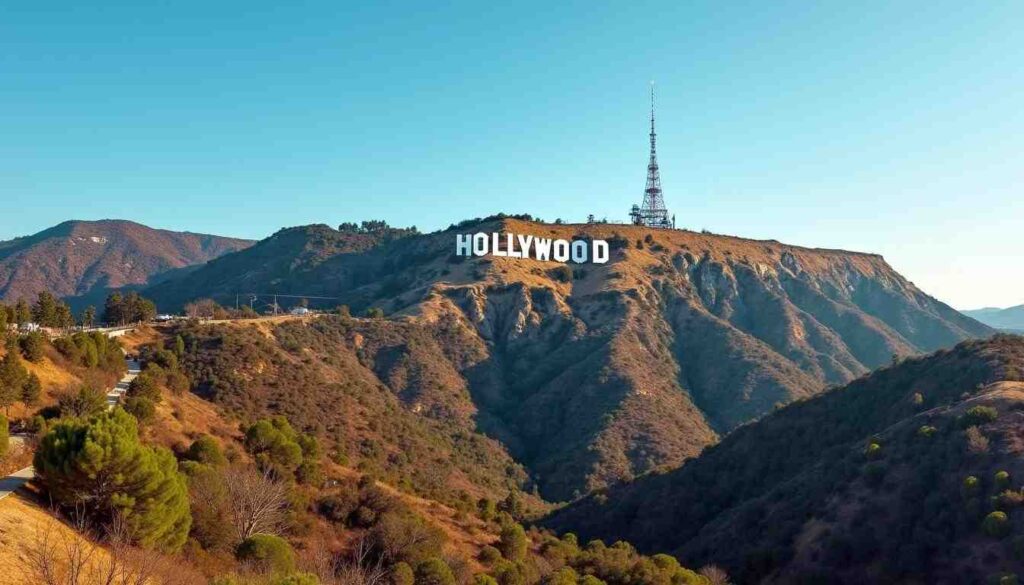
The Hollywood Sign never stopped being a cliché, but it’s also never stopped being the point. You hike up, turn around, and it’s all there — the grid of Sunset Boulevard, the low sprawl, the ocean held in the distance like a set piece waiting for its cue.
16. Hawaii, USA
The view from Waikīkī still feels like a movie set — Diamond Head in the distance, hotel pools in the foreground, surfers lining up between them. You’ve seen it before: Elvis in Blue Hawaii, George Clooney drifting through The Descendants, Adam Sandler rewriting the same day in 50 First Dates. The shots are sunny, edited for charm — but the layers underneath are older, slower, and less staged.
Oʻahu holds most of the storylines. Hawaii Five-0 made it procedural. Lost turned the jungle into something mythic. Pearl Harbor isn’t a metaphor here — it’s a real harbor, with the USS Arizona still visible beneath the water, oil still surfacing. The memorial doesn’t move. Neither does the weight around it.
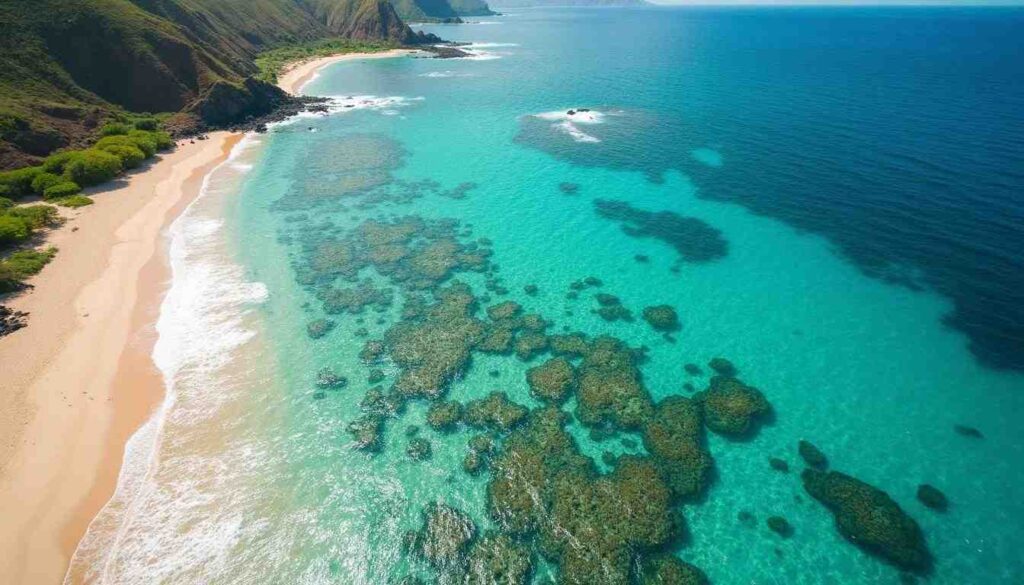
Maui brings a different rhythm. Road to Hāna curves through rainforest, roadside stands, cliff edges, and black sand beaches. No hurry, no playlist required. Parts of The White Lotus season one were filmed here, staged at the Four Seasons in Wailea — a satire, but one that couldn’t resist the view.
Kauaʻi was the original Jurassic Park — and still is. As well as ‘50 First Dates‘ primary filming location. Helicopter rides trace the same Na Pali Coast shots used in every sequel. On land, it’s quieter. Waimēa Canyon holds onto its color whether there’s a lens on it or not.
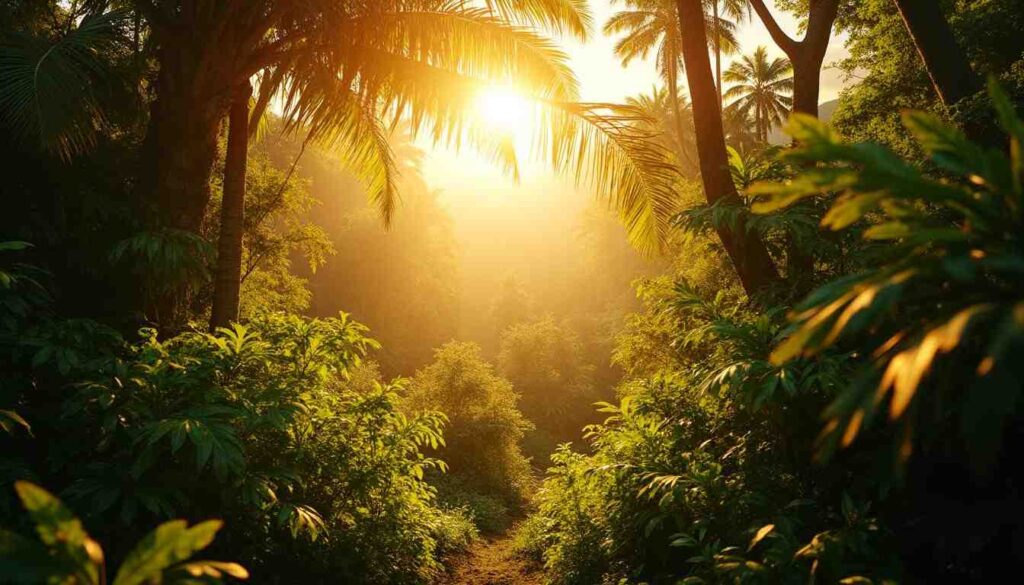
17. Alaska, USA
The Inside Passage moves slowly, cruise ships threading past fjords, bald eagles on driftwood, glaciers calving into quiet water. But on shore, the pace shifts. Skagway still looks like a gold rush town: wooden sidewalks, false-front buildings, stories sold as souvenirs. Dawson, Nome, and the Klondike live on in shop windows and street names. The dream hasn’t vanished. It’s just better organized.
Jack London put it on paper: the frostbitten optimism, the risk wrapped in ice. The Call of the Wild, White Fang, To Build a Fire. You’ll find copies in bookstores from Anchorage to Sitka, next to titles by Jon Krakauer and Velma Wallis. The themes haven’t changed much: isolation, grit, things that don’t apologize.
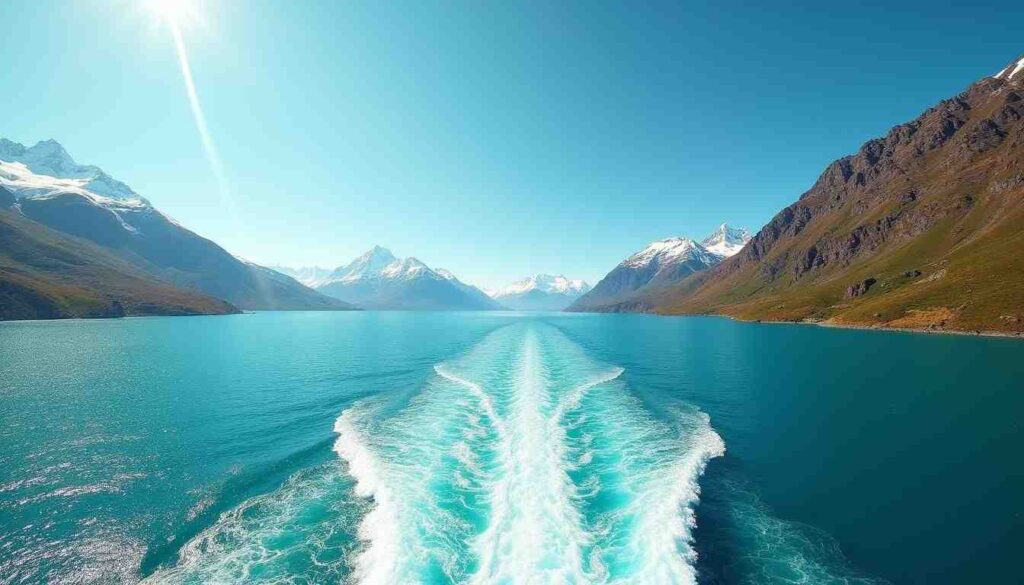
There’s wildlife, but it doesn’t show up on cue. Grizzlies along salmon rivers, moose near gas stations, and humpbacks moving slowly beside the boats.
Some visitors head inland for Denali, where the mountain pulls the horizon into a single point and clouds hide the summit more often than not. Others go south — to Glacier Bay, or further out toward the Aleutians — where the wind writes its own rules.
18. Paris, France
The carousel from Amélie still turns in Montmartre. The café is still there too — Les Deux Moulins — red awning, dim lighting, a dessert menu that hasn’t changed much. The neighborhood hasn’t frozen, but it’s held together.
Notre-Dame reopened in late 2024. The spire’s been rebuilt, the nave cleaned, and the doors are open again. Scaffolding remains on the upper exterior, but the inside glows brighter now, after years of restoration. Even unfinished, it draws the same silence.
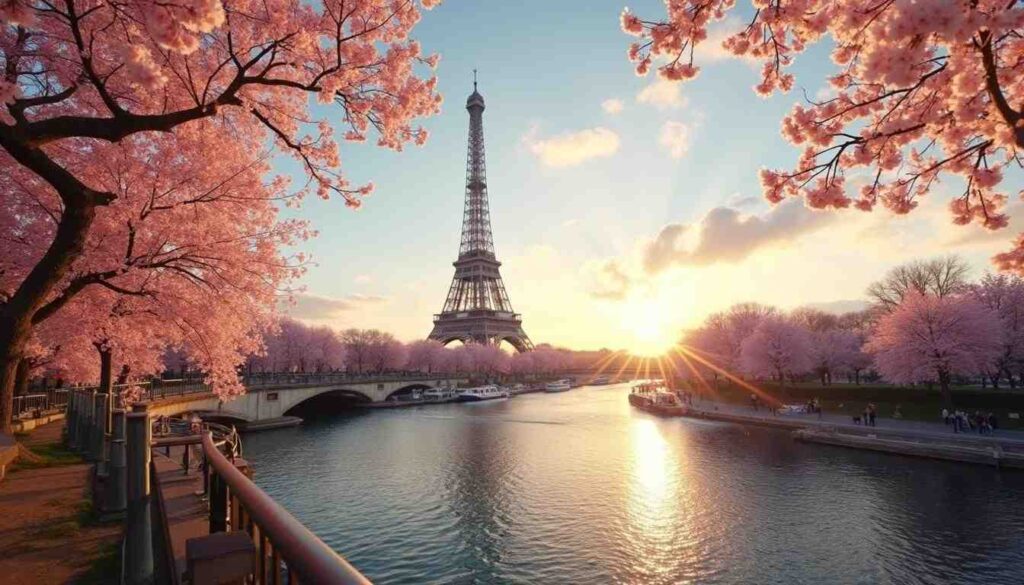
The Eiffel Tower doesn’t sneak up. Neither does the Louvre. In Murder Mystery 2, both were framed for action, but neither flinched. In Les Misérables, Paris moved from alleyways to uprisings to council chambers without losing its shape. Victor Hugo’s version still lingers in the stone.
Every part of the city feels like it’s already been filmed: Place Vendôme in soft focus, the bridges in Midnight in Paris, the Latin Quarter seen over someone’s shoulder during a bookshop monologue. The skyline hasn’t changed much, but the city keeps writing over itself. The Marais leans busy, Saint-Germain leans old, Belleville leans uphill. Some arrondissements feel staged, others don’t bother.
19. Venice, Italy
You arrive by train or by boat. There’s no gentle transition — one minute you’re on mainland platforms, the next you’re stepping into water and stone. The Grand Canal curves like it always has, lined with façades that fade perfectly. Venice doesn’t update. It absorbs.
During Carnival, the tone shifts. Capes and masks reappear, not like a festival but like a memory playing out in costume. In the back alleys, people check their reflections in dark windows. In the piazzas, photographers try not to blink. It’s theatrical, but not loud. Everyone’s part of it, whether dressed for it or not.
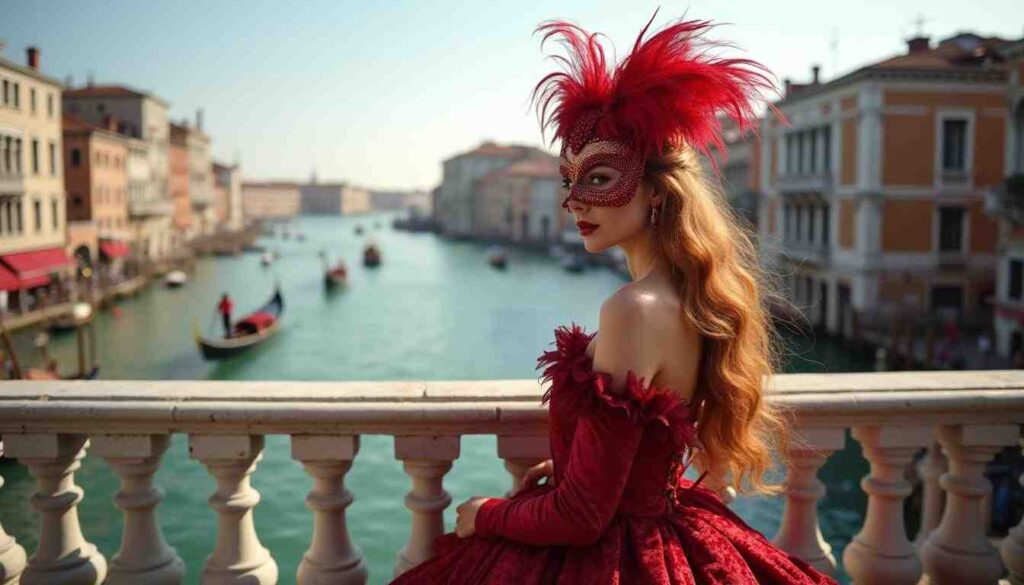
Don’t Look Now turned Venice into a slow-burn thriller. Casino Royale ended one chapter here. The Tourist used its canals as chase scenes. But Carnival brought it to film earlier in Senso, in Fellini’s Casanova, in dozens of period dramas that leaned on candlelight and anonymity.
You can cross the Rialto and still end up lost. That’s part of the point. Venice isn’t built on a grid — it’s a series of misdirections stitched together with bridges and time. Churches open into squares that weren’t on your map. Gondolas pass you like they’re not part of a job but a habit that hasn’t been unlearned.
20. London, UK
The streets are never clean of stories. Brick stays visible in places where newer cities would’ve covered it. Rain glosses everything without apology. Some parts feel like Sherlock just left. Others move at the pace of Fleabag — fast, unscripted, staring straight at you.
Walk long enough and you’ll trip across scenes you’ve already seen: Bridget Jones’s flat above The Globe pub. The bench from Notting Hill. Platform 9¾ marked inside King’s Cross for photos now, not travel. Bond steps out of the Whitehall buildings. The Crown reassembles royal interiors behind walls no one tours.
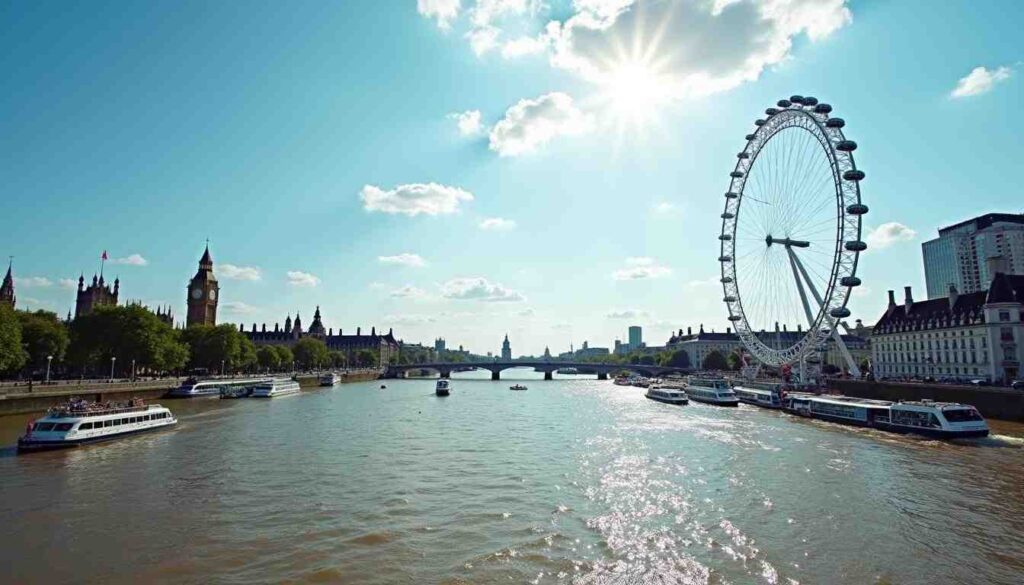
There’s the London of Love Actually, Lock, Stock, Children of Men, Paddington, V for Vendetta, 28 Days Later. The city doesn’t object — it’s always ready for another role. But underneath the edits, it still runs: markets under rail lines, kebab shops in Chelsea, double-deckers that seem like they’ve always been circling.
The Thames doesn’t try to be beautiful. It’s a working river, muddy and tidal. Southbank builds glass above it. The Tower stands like a memory no one wants to repaint. In the East End, streets fold between warehouses and curry houses. In the West, money filters everything, but doesn’t erase the noise.
21. Cinque Terre, Italy
The train cuts along cliffs, drops you off in a village where the buildings stack like cards held together by color. Then again, they all do. Monterosso, Vernazza, Corniglia, Manarola, Riomaggiore — 5 names said in a breath, each with its own rhythm but the same sea pressing at the edge.
Paths run between them. The Sentiero Azzurro isn’t long, but the steps are uneven and the heat holds. Some take the boat instead — the same view, slower. Either way, the perspective keeps shifting: lemon trees above, terraces on one side, open water on the other.
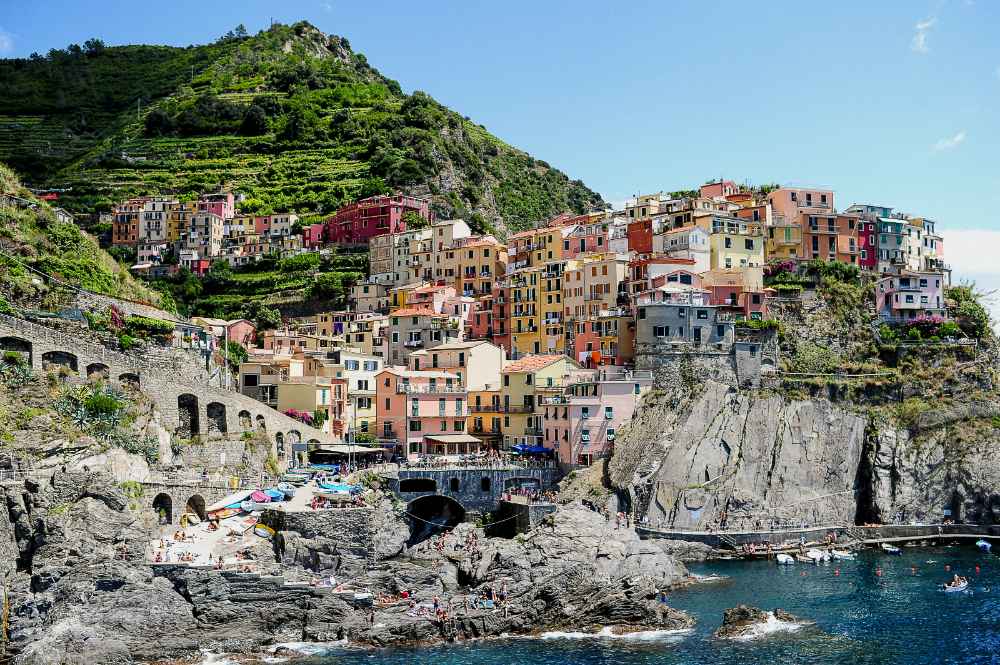
Movies like Luca borrow the mood — tight alleys, scooter engines, laundry strung like conversation. The villages have been filmed, painted, replicated, but they never flatten. Even in the middle of a crowd, the corners feel specific. A cat asleep on a windowsill. A line for anchovies that doesn’t move. A bar carved into stone, serving the same white wine from the same hillside.
22. Cappadocia, Turkey
The balloons are everywhere online — reels, TikToks, drone shots at sunrise. You’ve probably seen them more than once. But standing there, on a terrace with coffee still too hot to drink, and watching them lift off in total silence? That’s different. No filter, no music track, just the sound of burners and sky.
The landscape’s been shaped over thousands of years — volcanic ash turned into soft rock, then carved out by water, wind, and people who made homes inside it. Some of those homes are now hotels, restaurants, or actual apartments. Most don’t look like tourist spots. They just look like places that never stopped being lived in.
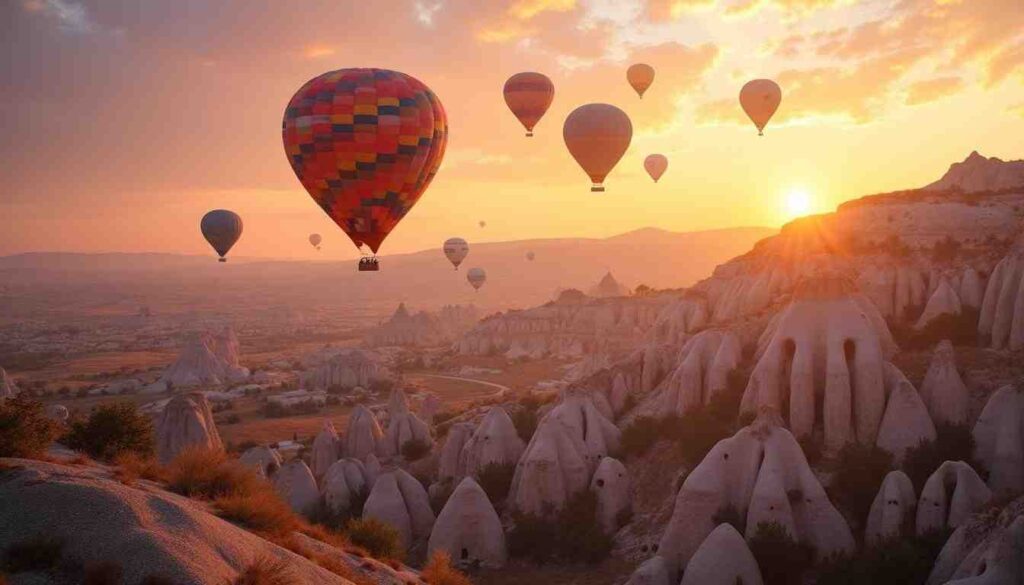
Cave hotels are more comfortable than they sound — heated floors, stone walls, low arches, often with rooftop breakfast spreads built for long mornings. Even if you skip the balloon ride, you still see them every morning if you’re staying in Göreme or Uçhisar.
There are valleys you can hike through — Rose, Pigeon, Love — with trails that dip through orchards and past cave chapels painted with fading saints. The underground cities are cooler (literally and otherwise) than most people expect. Rooms connected by tunnels that go deep enough to lose cell service — not that you’ll miss it.
23. Great Barrier Reef, Australia
You’ve probably seen it before. Not in person — but in Blue Planet, or The Year Earth Changed, or one of those documentaries narrated by David Attenborough where the coral pulses with color and the music swells like it’s telling you to feel something. It’s beautiful. But in person, it’s quieter.
Most people get there from Cairns or Airlie Beach. Day boats, liveaboards, reef pontoons. The trip out is longer than you expect, and when the engine cuts, the water changes — less blue, more glass. You drop in and the reef appears fast: fish moving like they’ve got somewhere to be, coral shifting from soft to sharp in a few meters, everything happening at once but without rush.
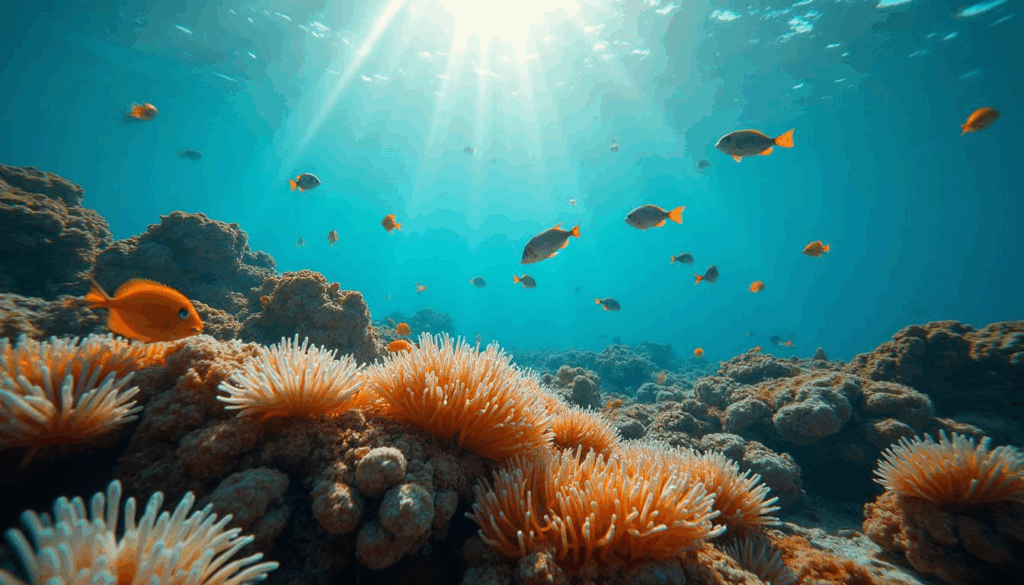
Finding Nemo made this place a character. The Pixar version was polished, but not wrong — the Great Barrier Reef really does have that many shapes, that much color, that kind of movement. In real life, it’s not as loud. More detail, less drama.
There are places where the coral is bleached. It’s not hidden. You see it in patches. And you see what’s still holding on — bright anemones, reef sharks in the distance, giant clams older than most boats floating above them.
24. Pamukkale, Turkey
Photos almost always overdo the blue. In real life, the water is clear with a tint, the terraces more chalk-white than snow. But they’re very real, natural thermal pools formed by calcium deposits over thousands of years. You can walk barefoot across the travertines, and yes, it’s slippery.
Pamukkale shows up often in travel reels and slow-pan videos. You might’ve seen it on The Amazing Race or an episode of Departures. What looks like ice from far away turns out to be warm stone, with shallow pools catching sky-colored water and reflections of people trying not to fall in.
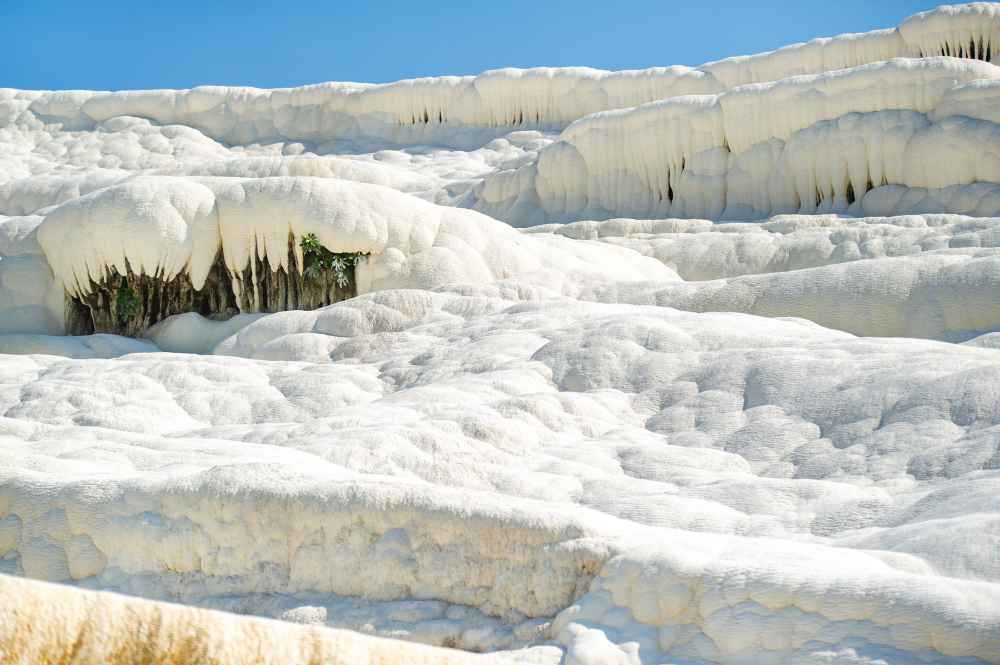
The ruins of Hierapolis are just above it, an ancient Roman spa town that feels oddly casual considering the scale. An amphitheater still sits up in the hills. Columns still lie half-buried in grass. There’s a pool you can swim in where the water flows around broken marble and fallen pedestals. They call it Cleopatra’s Pool, though no one’s pretending she was actually there.
Most people come for the terraces. They’re surreal, but not pristine — more photogenic than peaceful. Still, if you stay late or arrive early, there are moments when it goes quiet enough to hear the trickle of water moving between levels.
25. Meteora, Greece
Massive sandstone pillars, rising out of the Thessalian plain like they’ve been pulled from the earth rather than pushed up. The scale is quiet but complete. Even before you start climbing, the place already feels removed from everything around it.
The monasteries came later. Monks began building them in the 14th century, using ropes, pulleys, and whatever scaffolding they could manage. At one point, there were over twenty. Today, six remain active, still run by small communities of monks and nuns. They’re not ruins or museums. They’re living spaces — quiet, functional, and still sacred.
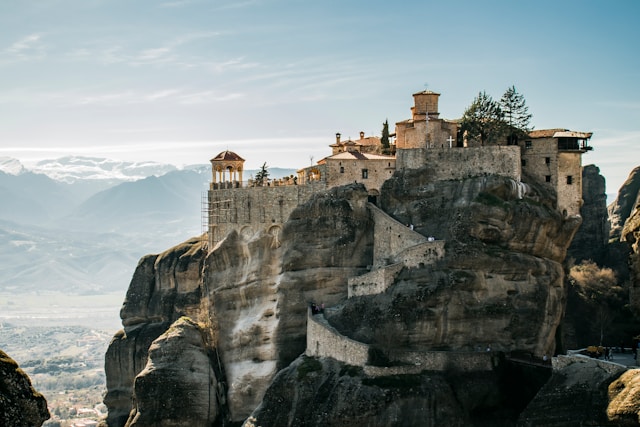
From a distance, they look almost imagined on cliff tops, window shutters open to nothing but sky. Up close, they feel more human. You’ll see old frescoes, simple wooden furniture, candlelight, and silence that isn’t staged.
Meteora has shown up in film and television — Game of Thrones used it as visual inspiration for the Eyrie, and For Your Eyes Only filmed scenes at the Holy Trinity Monastery. But it’s not a set, and it doesn’t play into drama. The landscape holds its own kind of gravity — part spiritual, part geological, entirely its own.
26. Barcelona, Spain
The first thing that stands out is the color. Not in a flashy or overwhelming way — it’s just everywhere, built into the city. You see it in the patterned tiles underfoot, in the soft blue shadows cast across pale stone buildings, and in the way sunlight moves through stained glass windows like it’s part of the design.
That feeling sharpens around Gaudí’s work. The Sagrada Família still climbs into the skyline with cranes above it and stone spires that seem both unfinished and permanent. Across the city, Park Güell leans into curves and color, with ceramic benches, tiled staircases, and structures that seem to shift even when you’re standing still.
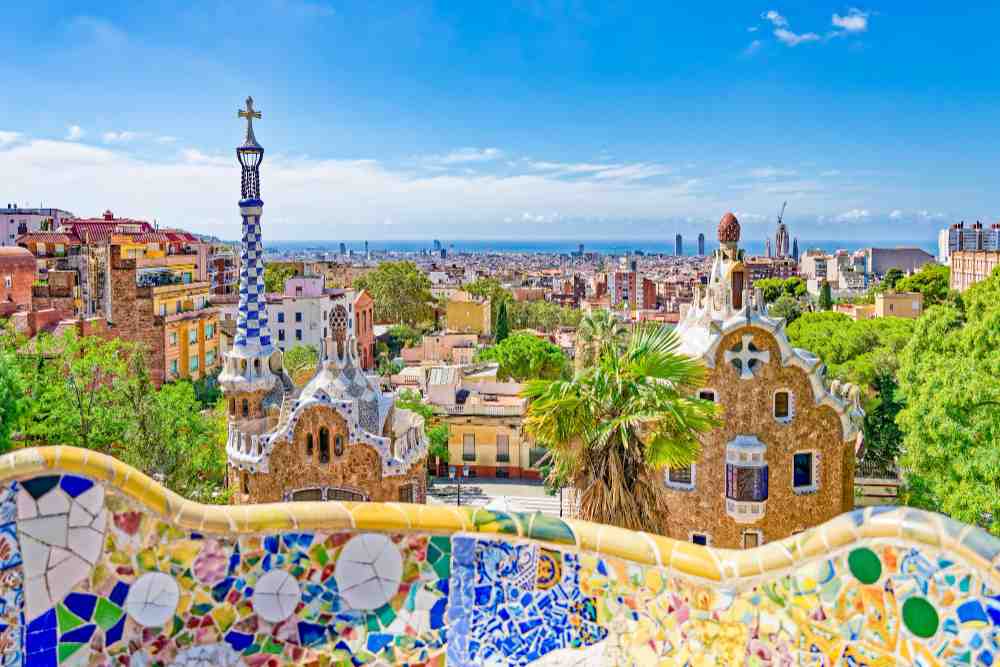
Vicky Cristina Barcelona gave the city its own kind of screen time — wine, rooftops, tension. All About My Mother layered it with quiet and grief. Even The Machinist and Biutiful used the outskirts and edges, reminding everyone that Barcelona isn’t all light and symmetry.
The Gothic Quarter folds in on itself. You walk a few blocks and realize you haven’t looked up in ten minutes. El Raval leans scruffier, more lived-in. Eixample opens up again — a tidy grid, wide boulevards, enough space between façades to see the sky.
27. Budapest, Hungary
You can walk past buildings from five different centuries without leaving a single street. Ottoman-era baths with steam rising from mineral water. Neo-Gothic banks and baroque concert halls. Socialist-era housing blocks that still wear their concrete without apology. Budapest never flattened its history — it layered it.
There are traces of 1956 everywhere. It’s a year that cracked the surface. The House of Terror museum is inside the former headquarters of both the Arrow Cross Party and, later, the Communist secret police. The past isn’t abstract. It has addresses. It has basements.
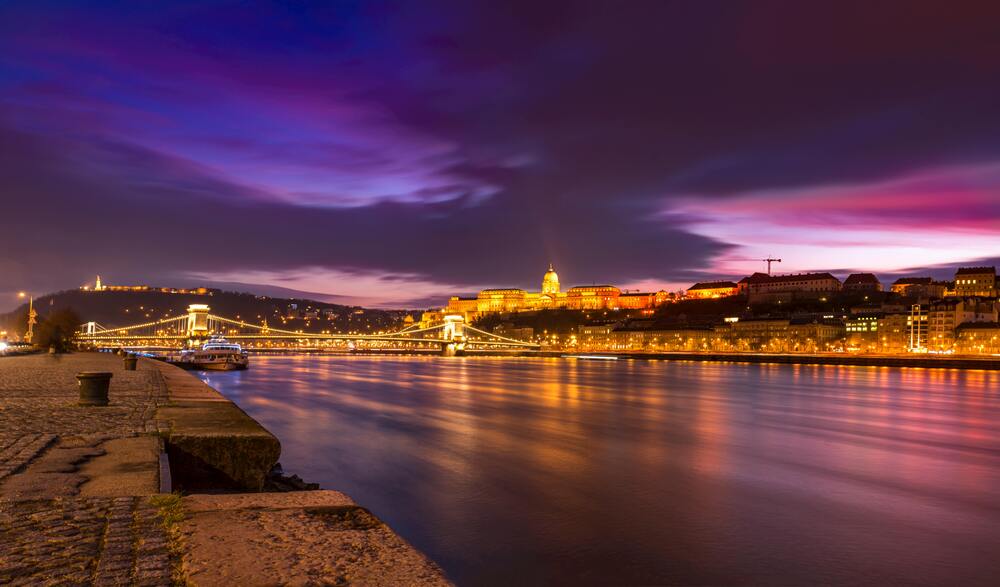
The Great Synagogue on Dohány Street stands as a reminder of what was nearly erased. It’s not only the largest synagogue in Europe — it’s a gateway to the Jewish Quarter, where you’ll find both Holocaust memorials and some of the city’s most active nightlife. That collision isn’t staged. It’s how the district evolved.
Liszt studied here. So did Bartók and Kodály, whose work still shapes Hungarian music education. Márai, Esterházy, and Kertész wrote through war, exile, and return; their books now on sale in minimalist bookstores that serve espresso and existentialism in equal measure.
28. Sardinia, Italy
Sardinia is technically Italy, but it rarely feels like it’s trying to be. The language — Sardu — still drifts through markets and small towns. Street signs often come in two versions, and the local accent pulls harder than anything from the mainland.

The Nuraghe are everywhere, thousands of stone towers built in the Bronze Age, older than the Roman ruins most visitors come looking for. Some sit in fields, half-collapsed and unmarked. Others, like Su Nuraxi in Barumini, still hold their shape, with inner corridors and dry stone architecture that’s been standing for 3,000 years. There’s no clear narrative around them, no myth to wrap it up neatly. Just presence.
Sardinia’s shown up on screen a few times — Swept Away (the original one) used its coasts for tension, The Spy Who Loved Me dropped a Lotus Esprit into its curves, and more recently, it’s been used to stand in for more anonymous “Mediterranean” settings.
29. Istanbul, Turkey
One foot in Europe, the other in Asia, and the city never acts like it has to choose. Ferry horns cut through the air. The call to prayer drifts across rooftops five times a day. And between it all, life moves in the space where contrasts stop feeling like contradictions.
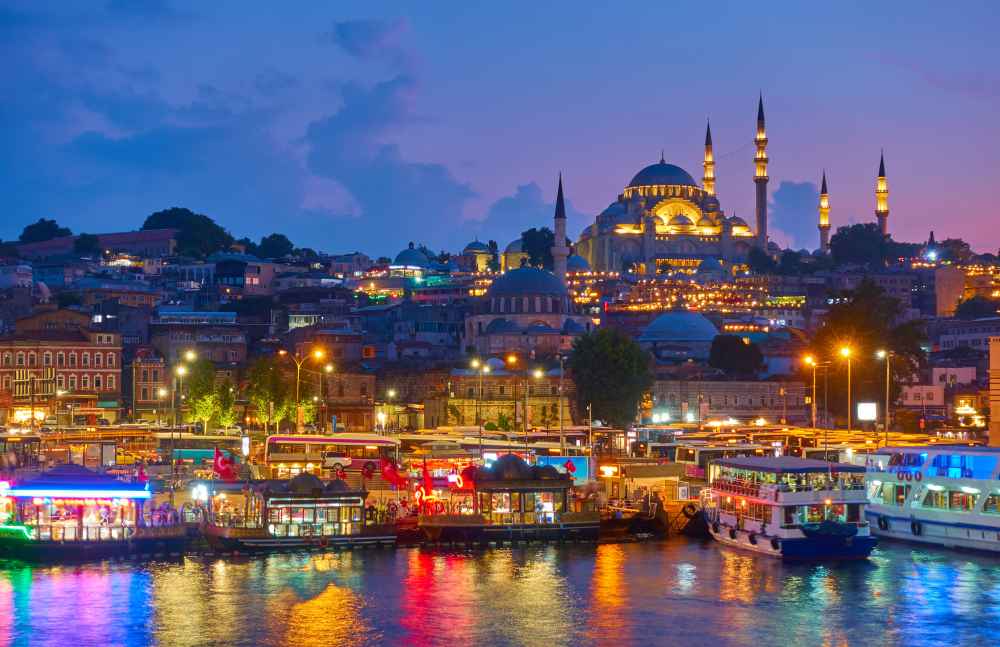
History here doesn’t sit behind glass. It’s built into everything — walls from the Byzantine empire, Ottoman fountains still flowing, tramlines running past Roman ruins without ceremony. The Hagia Sophia holds layers of faith in its structure alone: church, then mosque, then museum, and now a mosque again. The Blue Mosque stands nearby, still active, still drawing people in with its balance of scale and silence.
Down the hill, Sirkeci Station still stands — smaller than you expect, but no less important. It was the eastern terminus of the Orient Express, the train line that brought travelers from Paris to the edge of Europe, depositing them into a city that already felt like a story. Agatha Christie set part of Murder on the Orient Express here, and legend claims she wrote it at the Pera Palace Hotel, where her room is still marked.
30. Scottish Highlands, Scotland
The road north from Edinburgh or Glasgow feels like it slowly pulls you out of the present. Villages thin out. Mountains stop being distant and start pressing closer. By the time you reach places like Glencoe or Torridon, the edges are sharper, and the silence feels like part of the terrain.
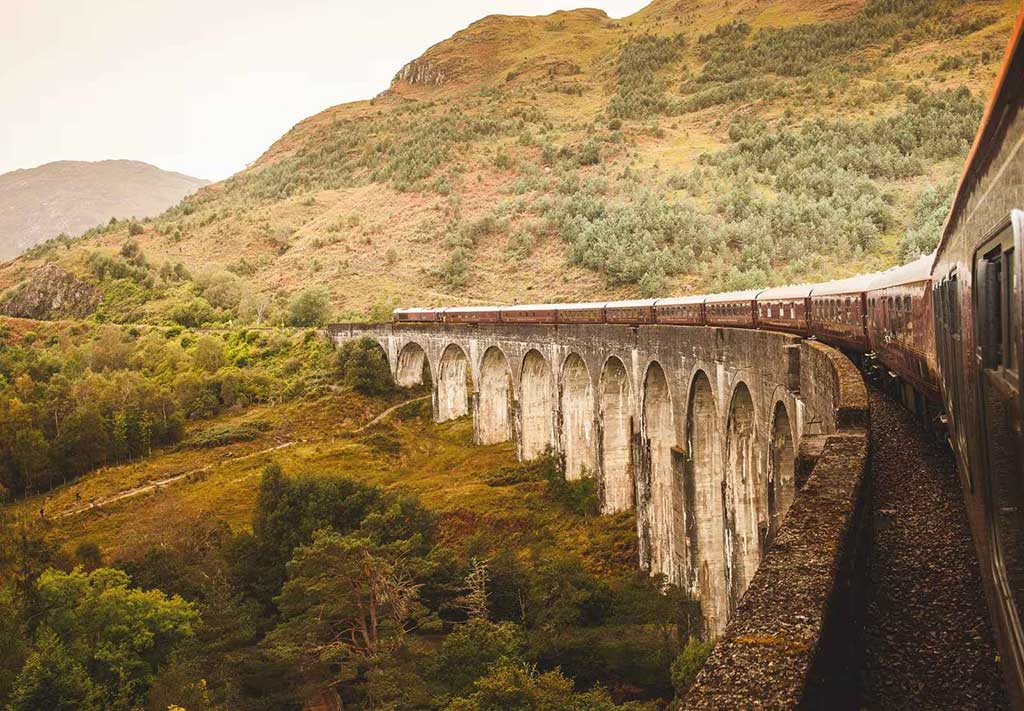
Writers have been drawn here for centuries — not because it’s remote, but because it holds a kind of scale that resists summary. Robert Louis Stevenson spent time in the Highlands and wrote about the wildness without romanticizing it. Nan Shepherd walked the Cairngorms so often she called them “a region of subtlety,” and her book The Living Mountain still feels more current than most modern nature writing.
The landscape shows up in film often, but rarely by name. The opening scenes of Skyfall place Bond’s childhood home in Glencoe, with hills rolling out in every direction like unfinished sentences. Braveheart filmed here too, though it shaped history into legend. More recently, the Highlands were the backdrop for Outlaw King and The Crown, where the scenery didn’t need much from the script.
31. Serengeti National Park, Tanzania
The numbers are hard to process. Over a million wildebeest. Thousands of zebras. Gazelles in the mix, moving with them. From the air, the herds look like shifting brushstrokes across the plains. From the ground, it’s dust, hooves, and motion that doesn’t seem to pause for anything.
The Great Migration follows rain. It doesn’t stick to dates or itineraries. From the southern Serengeti toward the Grumeti River and up into the Maasai Mara, the movement keeps going, crossing rivers when the water’s high, scattering when predators show up.
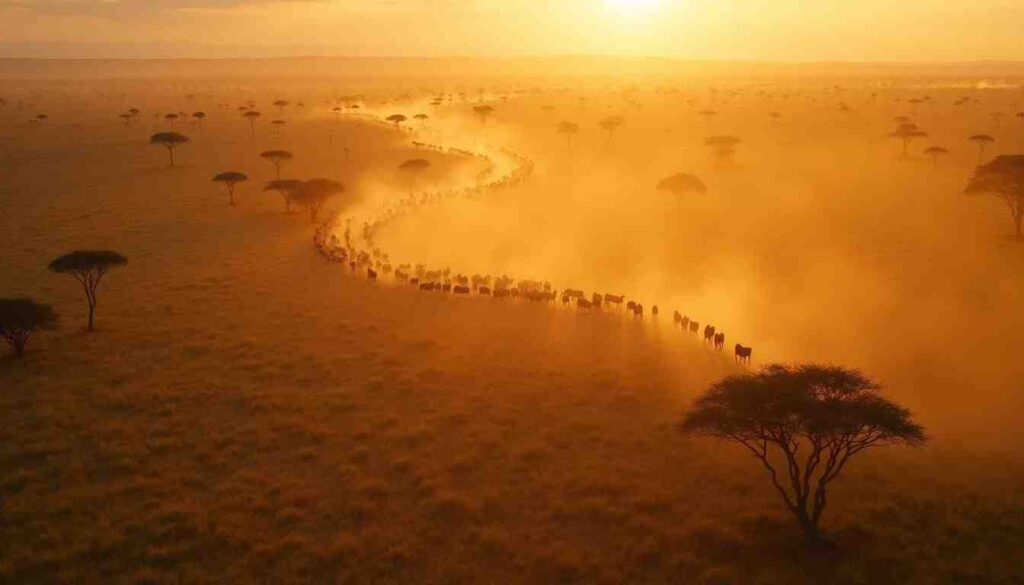
Documentaries have been tracking it for decades. Planet Earth, The Hunt, Serengeti, The Year Earth Changed. The narration always leans into rhythm and survival, and it’s accurate. But being there changes the pacing. You wait. You scan the horizon. You notice how quiet it gets just before a herd starts running.
Lodges and mobile camps shift position depending on the time of year. Some are built for views, others for proximity. Local guides know the terrain more by patterns than coordinates.
32. Florence, Italy
The streets curve in ways that weren’t meant for cars. Stone buildings lean in close, their facades aged but steady. You can walk for ten minutes and pass more names from textbooks than you might in a semester — Dante, Brunelleschi, Botticelli, Michelangelo.
The Duomo catches you off guard, no matter how many pictures you’ve seen. Up close, the detail is obsessive — green, pink, and white marble shaped into geometry that doesn’t repeat. If you look up long enough, your neck starts to ache. If you climb to the top, the city opens in every direction like a planned reveal.
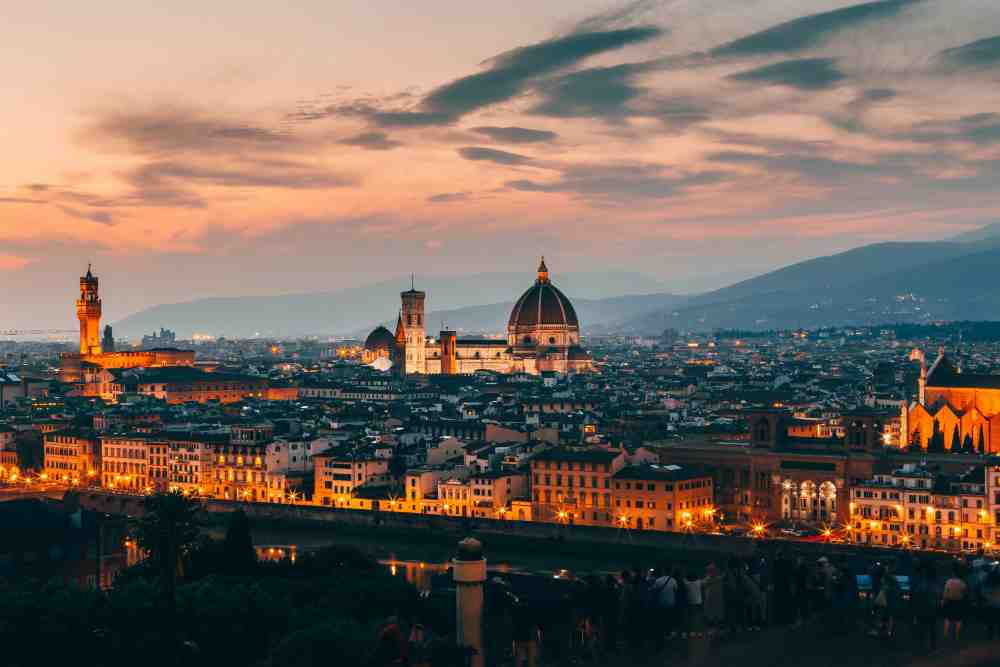
In the Uffizi, rooms shift from one master to another without much ceremony. People stand quietly in front of The Birth of Venus, often longer than they planned to. Downstairs, Caravaggio leans darker.
In the evenings, the rhythm slows. Piazza Santo Spirito fills with conversation and plates passed between tables. Church bells drift over rooftops. Light lingers on the Arno before the water disappears into shadow.
33. Santorini, Greece
White buildings spill over the cliffs in a way that feels precise without being symmetrical. The caldera sits below, a volcanic basin that hasn’t erupted in centuries, filled now with water and light. Ferries thread across the blue in slow arcs. Rooftops stack above one another, each with just enough space for a table, a chair, and someone leaning into the breeze.
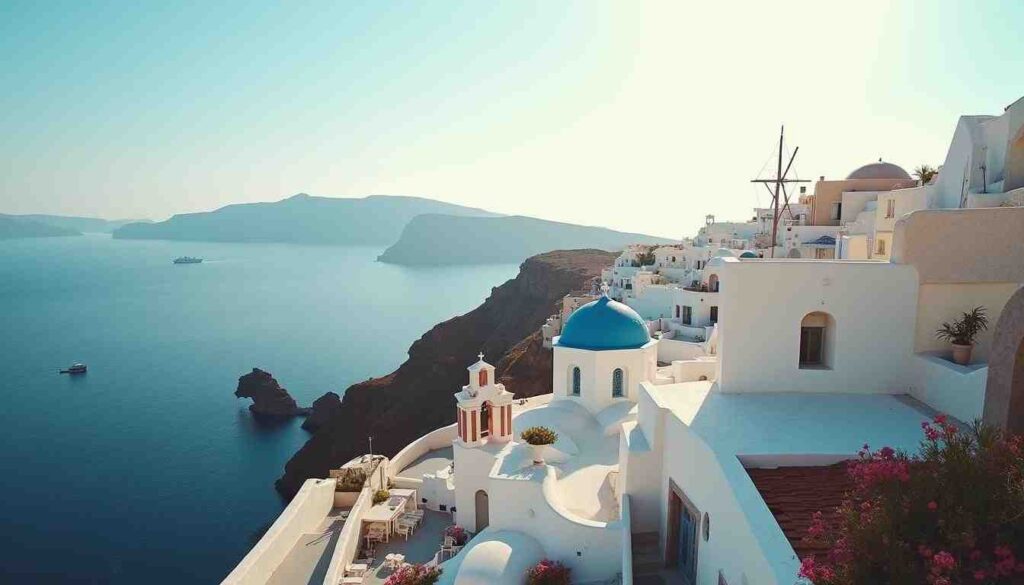
The island carries history even when it doesn’t mention it. Ancient Thera sits inland, half-buried, with stones still marking streets and homes from thousands of years ago. Akrotiri, preserved under volcanic ash, holds the outlines of a Bronze Age city that vanished without ceremony.
Santorini’s shown up on screen often, usually framed through weddings or long-lost romances. The Sisterhood of the Traveling Pants filmed scenes here. So did Lara Croft: Tomb Raider – The Cradle of Life. The scenery always survives the plot. Even in photos, it doesn’t need much explanation.
At sunset, people gather along the cliffs in Oia. They’re not rushed, and no one needs a reason to stop and watch. The light moves slowly down the buildings until only the sea holds what’s left of the day. Later, you’ll hear voices from terraces and plates being cleared without hurry.
34. Zanzibar, Tanzania
Stone Town holds its shape in narrow alleys and carved wooden doors, many older than the countries tourists arrive from. Persian, Arab, Indian, Swahili, and European influences left fingerprints in the architecture, the language, and the food. You see it in the mashup of styles: carved balconies next to coral stone walls, spiced rice served with tamarind sauce, Indian textiles folded next to cloves and vanilla.
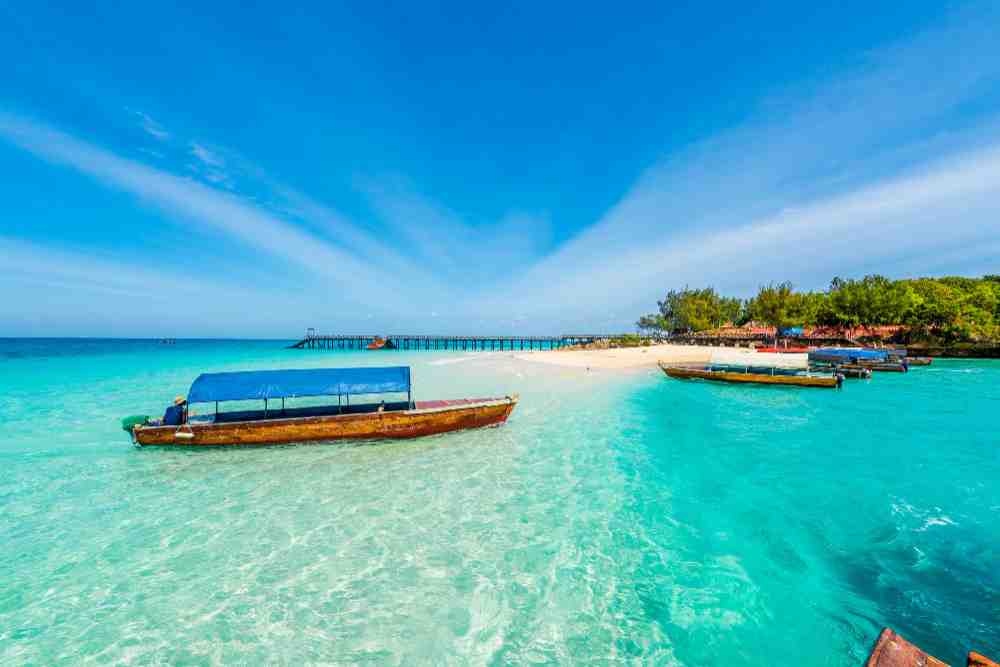
Zanzibar played a role in the spice trade and the East African slave trade, and neither is buried deep. The Anglican Cathedral stands on the site of a former slave market. Inside, markers show the outlines of holding cells. Outside, people sell fruit and carved animals beside memorials that don’t explain themselves unless you stop to read them.
Freddie Mercury was born here, back when Zanzibar was a British protectorate. There’s a modest museum now, but the connection feels more like a footnote than a theme. Learn about the spice trade history at the Spice Plantations and relax on the pristine beaches of Nungwi and Kendwa. Explore Stone Town’s winding alleys and historic architecture.
35. Bali, Indonesia
There’s a rhythm here that settles in fast. Morning light stretches across rice terraces before most people have opened their laptops. Motorbikes weave through Ubud’s narrow streets with baskets of fruit and yoga mats strapped to the back. Around every corner, there’s a warung with strong coffee and something spicy on the stove.
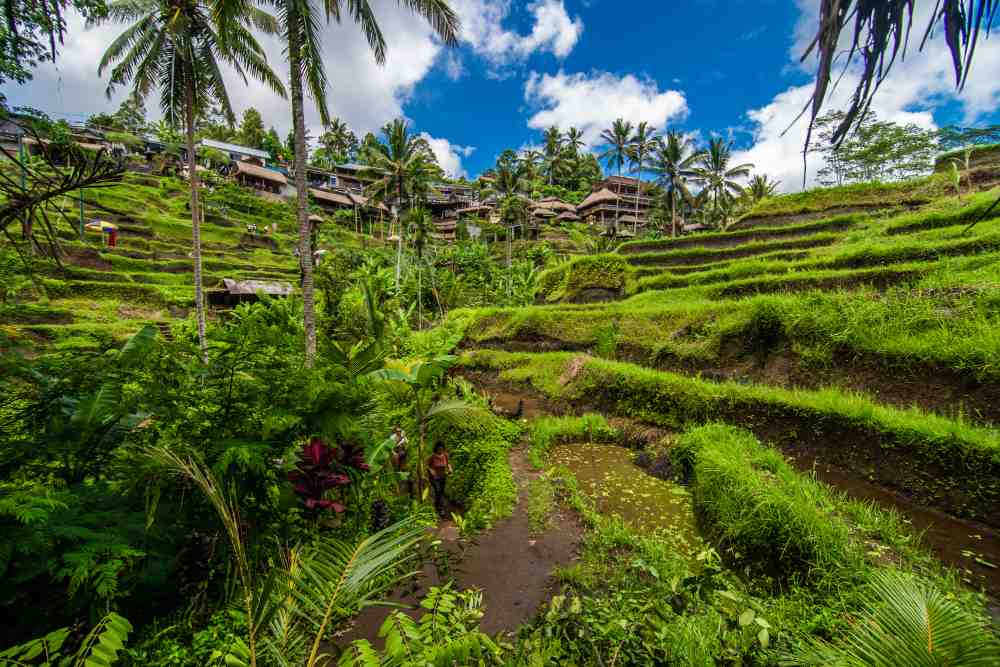
Bali has become a second home to remote workers, wellness travelers, and people on pause. Coworking spaces in Canggu fill with freelancers by 9 a.m., barefoot and already caffeinated. By sunset, they’re down at the beach, watching the sky go full orange behind a line of surfers still waiting for one more wave.
Temples are everywhere, they’re part of daily life. Offerings of flowers and rice rest on sidewalks and doorsteps. In Uluwatu, ceremonies unfold above the sea cliffs, and the air smells of incense long after the crowd drifts away. Spiritual retreats in Sidemen and Munduk keep their windows open to mountain air and frogs singing at night.
36. Kyoto, Japan
The streets in Gion look almost exactly like you remember them. Narrow, cobbled, lined with wooden facades and low lanterns. If you watched Memoirs of a Geisha, that image probably stuck, the quiet tension, the measured footsteps, the kind of beauty that never asks for attention. Being there feels less like stepping into a film and more like remembering something already stored in your head.
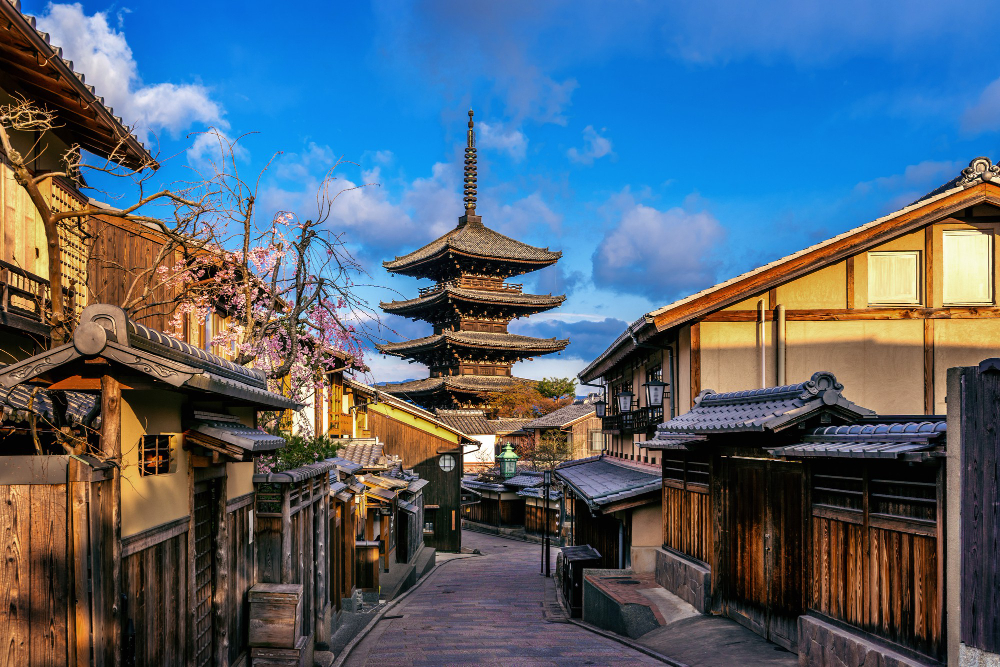
Spring changes everything. The cherry blossoms don’t drift down gently, they fall fast, fill the riverbanks and temple paths like confetti, and vanish almost as quickly. You might walk the Philosopher’s Path in the late afternoon and find it quiet again by morning, the blossoms thinned out, the crowd somewhere else.
Shōgun might have taught you about power, but Kyoto teaches stillness. It’s in the way incense burns inside Kiyomizu-dera, how shadows fall across tatami mats, how the sound of sandals on stone carries further than it should. The city never performs its history.
37. Dubai, UAE
Most people’s first impression of Dubai comes through a screen. A rooftop infinity pool, a drone shot over the Palm, someone stepping out of a G-Wagon in sunglasses they probably got paid to wear. The videos show the surface, but they’re not wrong.
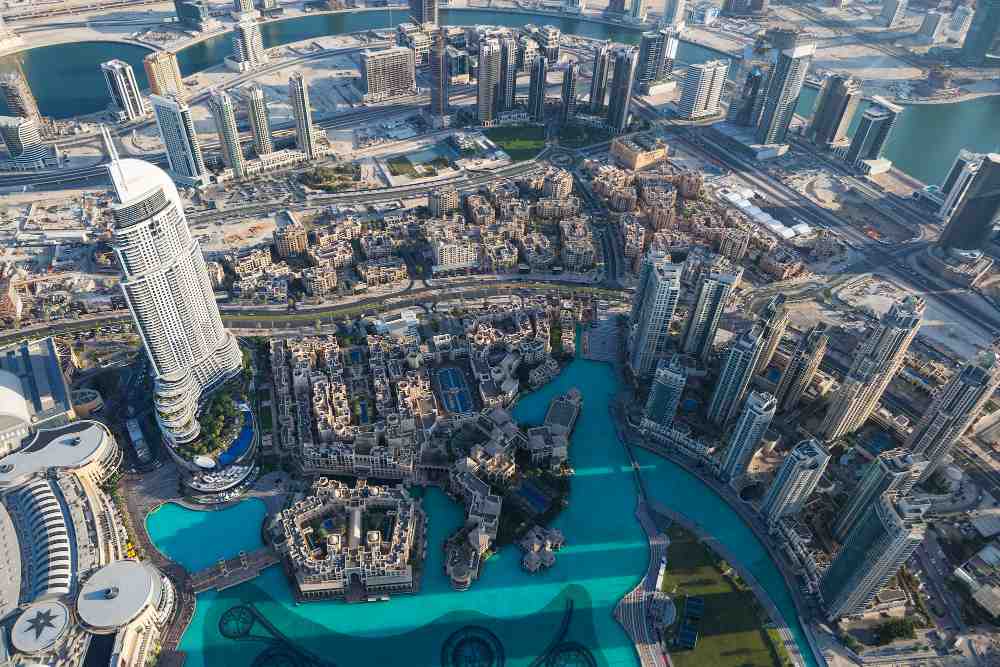
Downtown feels like the center of a game that never ends. The Burj Khalifa reflects the sky and heat all day and turns into a light show by night. Below it, the malls go beyond shopping with ice rinks, art galleries, and restaurants where someone’s always vlogging their meal. Cafés double as coworking lounges. You hear crypto calls over flat whites and people pitching side hustles between sets at the gym.
In Jumeirah and Dubai Marina, influencers shoot sunrise yoga and outfit transitions next to luxury cars that stay parked just long enough to catch golden hour. Some live here full time. Others pass through for launches, conferences, or a couple of well-placed reels. The content moves fast. So do the careers it builds.
38. Yosemite National Park, USA
The views come at you fast — granite walls, pine forests, waterfalls that drop so far they pull mist from the air. Half Dome gets most of the attention. El Capitan holds its own without needing to. Some visitors hike. Others just stop by the valley floor and take it all in from behind a windshield.
But there’s another version of Yosemite — the one that doesn’t show up on postcards. People disappear here. Always have. Kids, experienced hikers, people walking twenty yards from a group. Some are found hours later in places that don’t make sense. Others are never found at all.
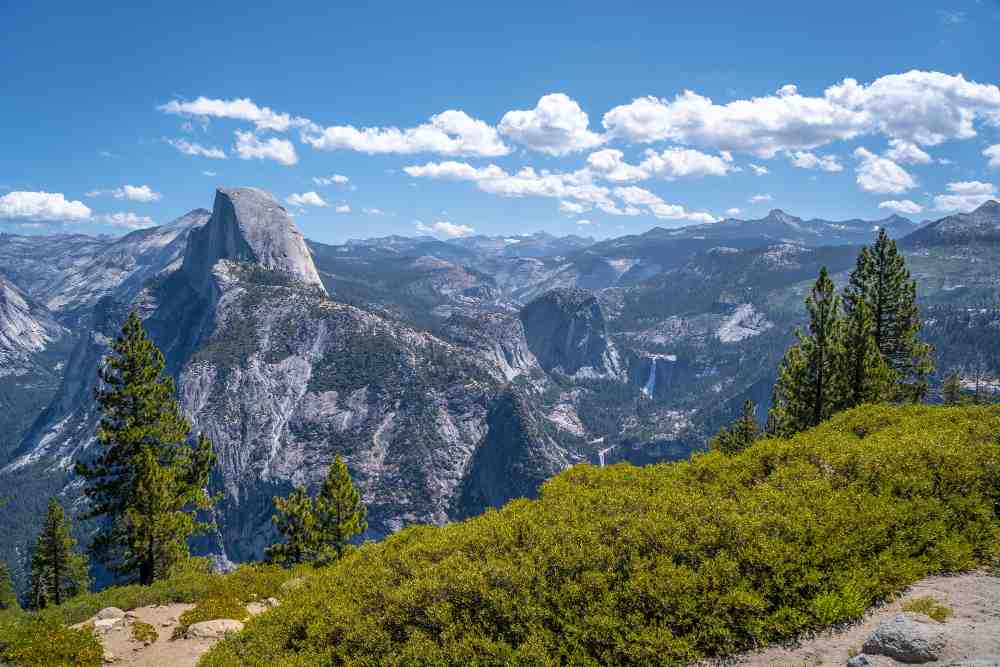
The Missing 411 books and documentaries brought more attention to it — patterns of disappearances in national parks, Yosemite among the most frequently named. No single theory explains it. The terrain is complex, the park is massive, and search efforts don’t always reach every ridge or ravine. But the details linger. Footprints that stop mid-trail. Clothing folded, shoes missing. No signs of struggle, no sound reported. Just gone.
Rangers don’t advertise this part. And it doesn’t stop people from coming. The park draws millions each year, and most trips are uneventful. But the stories are there, in forum threads and fire-side conversations, often shared by people who don’t consider themselves superstitious.
There’s no official record that ties all the disappearances together. Just the landscape — stunning, ancient, and still largely unmapped in certain corners. The kind of place where silence feels thicker than air, and where sometimes, no one can explain what’s missing.
39. Grand Canyon, USA
Most people first see the Grand Canyon from the rim. You park, walk a few steps, and the ground falls away in silence. The Colorado River glints far below, thin as thread. Layered rock stretches across the horizon like it was drawn with one long, steady hand. There’s no need to frame it. It’s already framed.
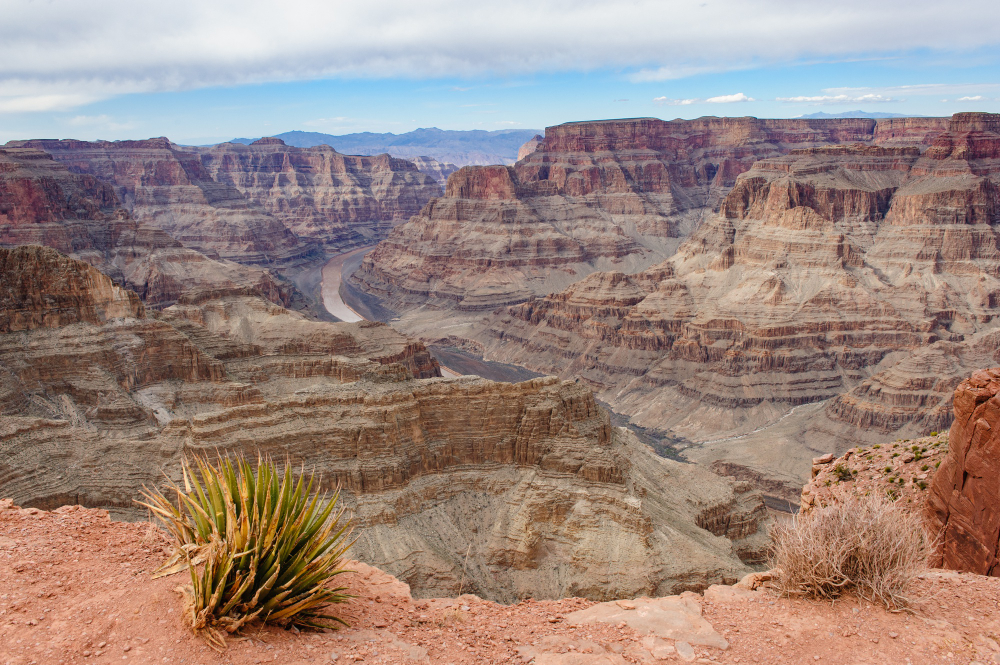
It’s been the backdrop for a lot of stories. Thelma & Louise drove here for their final shot. Into the Wild stopped by before vanishing into Alaska. National Geographic, IMAX, survival blogs — they’ve all tried to explain it. Edward Abbey wrote about the desert around it. Kevin Fedarko’s The Emerald Mile follows a record-breaking speed run down the river, 3 men in a wooden dory, riding floodwater from a dam release, no margin for error.
40. Prague, Czech Republic
The streets still follow medieval logic — winding, uneven, more interested in mood than efficiency. At night, the light from gas-style lamps hits the cobblestones in a way that feels scripted, but the city’s not performing. It’s just always looked like this.
Kafka was born here and never really left, even when he lived elsewhere. The apartment near Old Town Square still carries his name. His characters — anxious, stuck, watching the walls shift — feel like they came from the alleys themselves. Milan Kundera later folded the same city into a different tone: philosophical, wry, unsure whether to trust its own memory.
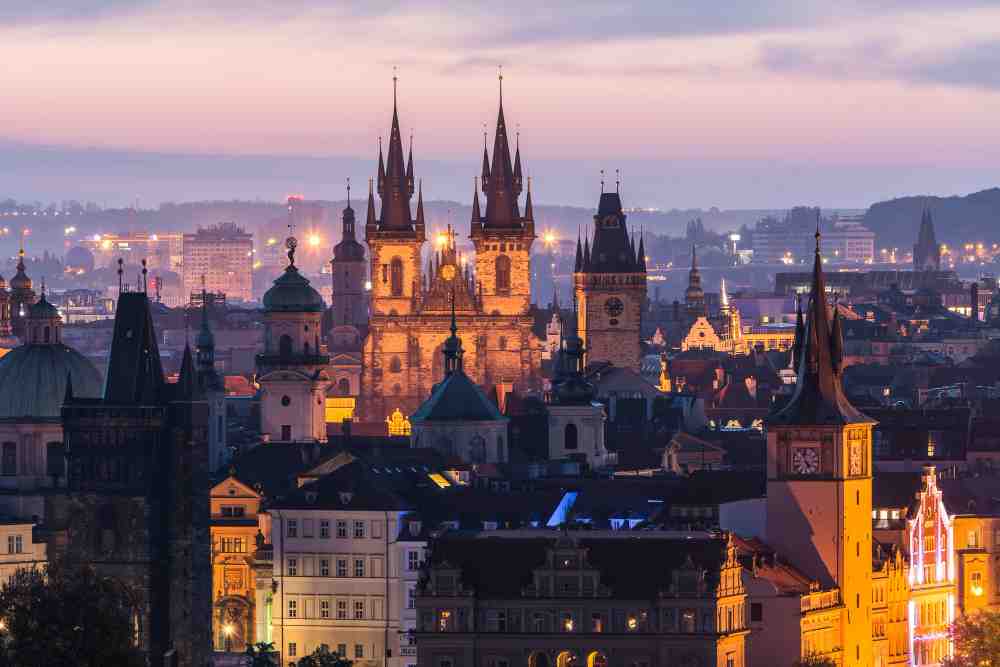
Writers didn’t have to invent atmosphere. The Astronomical Clock still ticks in its medieval rhythm. Charles Bridge holds statues that seem more watchful than decorative. The Vltava moves slowly under the weight of so many versions of Prague layered together.
Filmmakers have used it for places that need texture without translation. Mission: Impossible, The Illusionist, Casino Royale, and Amadeus all shot here — drawn to the arches, staircases, and courtyards that don’t look like they belong to one single time period. You walk through a plaza and feel like the setting could turn Baroque, Cold War, or Gothic depending on the angle.

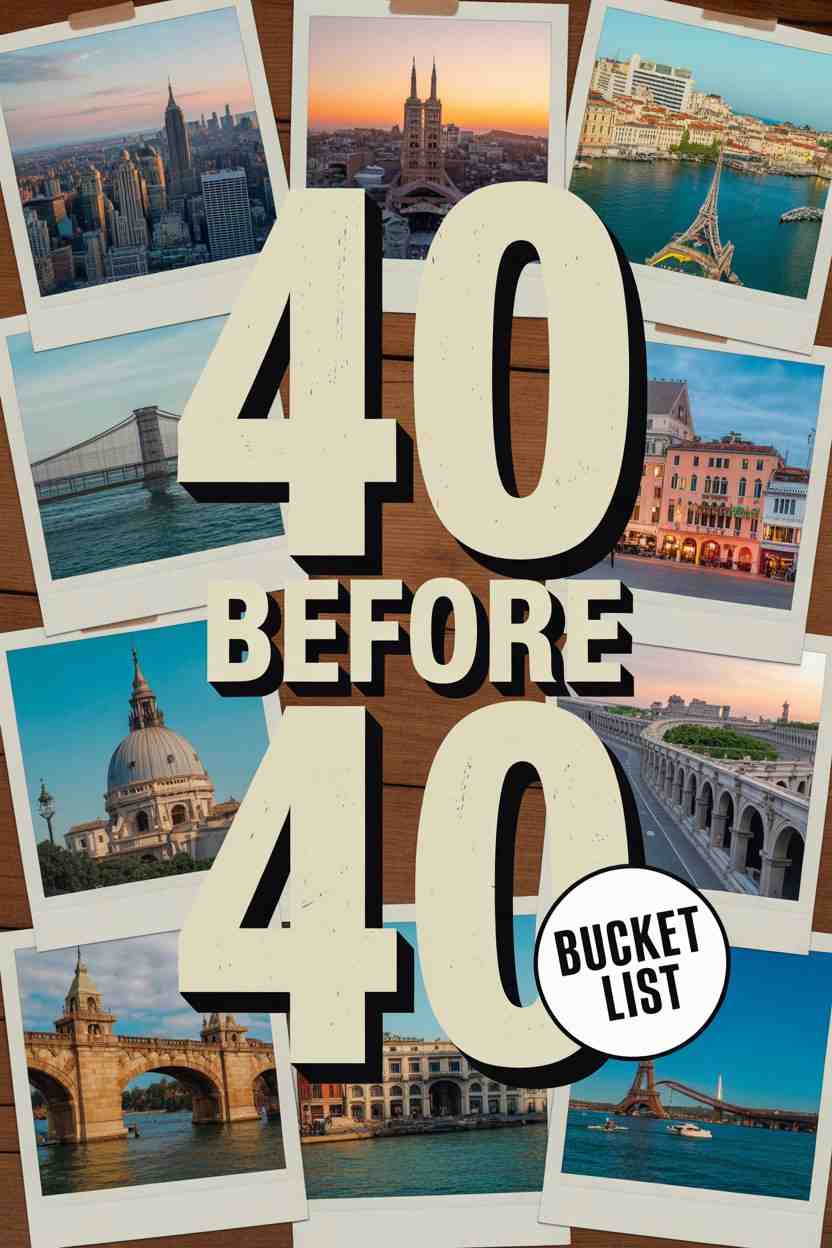
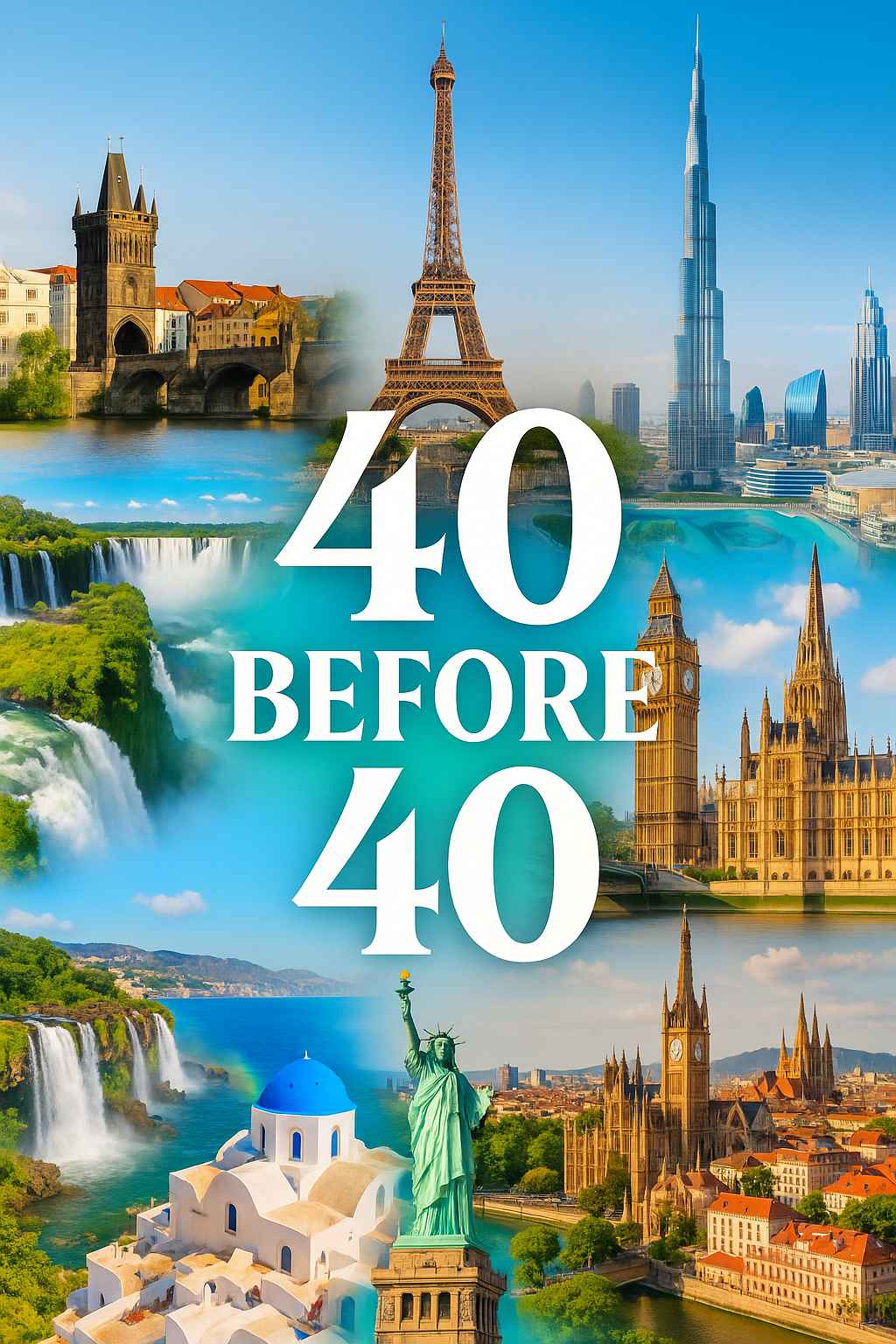
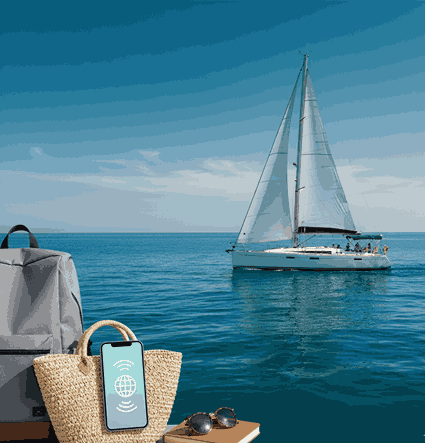



Comments